


Publisher:
Lawrence Business Magazine, LLC
Ann Frame Hertzog & Steven Hertzog
Editor-in-Chief:
Ann Frame Hertzog
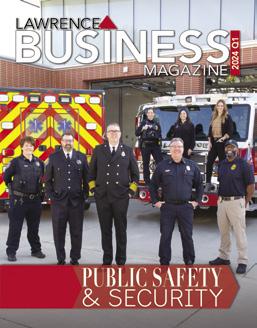
ON THE COVER FRONT ROW:
Undersheriff Stacy Simmons
Sheriff Jay Armbrister
Fire Chief Richard Llewellyn
Police Chief Rich Lockhart
Lieutenant Myrone Grady
BACK ROW:
Officer Lindsay Bishop, Deputy Dir. of DCEM
Jillian Rodrique
McKenzi Ezell, Fire Medical Data Analyst
Chief
Photographer:
Steven Hertzog
Featured Writers:
Bob Luder
Patricia A.
Michaelis, Ph.D.
Emily Mulligan
Nick Spacek
Tara Trenary
Darin M. White
Copy Editor:
Tara Trenary
Contributing
Writers:
Jeff Burkhead
Contributing
Photographers:
Jeff Burkhead
Taylor Mah
LETTER FROM THE PUBLISHERS
In 2015, we did an Impact issue on Public Safety; nine years later, it is a different world with a new perspective. We decided it was time to revisit the subject, see what has changed and evolved, and how we look at Public Safety and Security in 2024.
One thing we do know, public safety is a multi-faceted endeavor that involves the collaborative efforts of various departments and agencies dedicated to serving and protecting the community. Among the key entities responsible for ensuring public safety in the community are the Police Departments, Fire Departments, Sheriff’s Office, and the Douglas County Emergency Management Agency. Each of these organizations plays a vital role in safeguarding the well-being of Douglas County residents and visitors, responding to emergencies, and maintaining the city’s overall security.
Public safety ensures the physical well-being of the residents. It encompasses the efforts of law enforcement agencies, firefighters, emergency medical services, and various community organizations dedicated to preserving life and property. Public safety is also pivotal in promoting social cohesion and community resilience. We take pride in our community’s reputation as a safe and welcoming place – diverse and inclusive. Strong community partnerships between law enforcement agencies, neighborhood associations, schools, and local businesses foster trust, collaboration, and mutual support. Through initiatives such as community policing, crime prevention programs, and neighborhood watch groups, our residents actively contribute to maintaining public safety and creating a shared sense of responsibility for the well-being of our communities.
INQUIRIES & ADVERTISING INFORMATION CONTACT:
info@LawrenceBusinessMagazine.com
LawrenceBusinessMagazine.com
Lawrence Business Magazine, LLC
3514 Clinton Parkway, Suite A-113
Lawrence, KS 66047
©
distributed at key retail locations throughout the area and mailed to individual subscribers. All rights reserved. No part of this publication can be reprinted or reproduced without the publisher’s permission. Lawrence Business Magazine, LLC assumes no responsibility for unsolicited materials. Statements and opinions printed in the Lawrence Business Magazine are the those of the author or advertiser and are not necessarily the opinion of Lawrence Business Magazine.
We see public safety as paramount to our diverse and inclusive community’s vitality, prosperity, and well-being. As in every issue, we learn a bit about the community, and this issue was no exception. We are proud of the dedication and commitment to protecting the citizens and making sure everyone is and feels safe, a priority for the leadership of all of the organizations that work together to maintain our security.
Please note that all of our advertisers have a stake in the local economy; we ask you to first consider them before looking to source your needs outside of the community. Try and shop locally as much as possible and avoid the urge to order online. If you find something online –see if one of our local businesses has it. We know they would appreciate the business - our local businesses are at the center of our community.
When we Shop Local - Shop Baldwin, Eudora, Lecompton, and Lawrence (and use Local Services) - we are supporting those businesses, giving back to our community, and building a future together.
Sincerely,
 Ann Frame Hertzog
Ann Frame Hertzog
 Editor-in-Chief/Publisher Chief Photographer/Publisher
Editor-in-Chief/Publisher Chief Photographer/Publisher
4
www.LawrenceBusinessMagazine.com
LLC
2024 Lawrence Business Magazine,
distributed
businesses
County Community. It is
Lawrence Business Magazine, is published quarterly by Lawrence Business Magazine, LLC and is
by direct mail to
in the Lawrence & Douglas
also
2021 Q3 2024 Q1 & DOUGLAS COUNTY
Photo by Steven Hertzog




7 TO UPDATE YOUR ADDRESS OR FOR SUBSCRIPTION INFORMATION: LawrenceBusinessMagazine.com/subscriptions/ CONTENTS 08 Lawrence in Perspective: Water, Waster, Everywhere by Patricia Michaelis, Ph.D. 20 Safety is Top Priority by Tara Trenary 28 On Full Alert by Emily Mulligan 36 Blazing A Path Forward by Nick Spacek 44 The Right Way to Serve by Bob Luder 56 To Protect and To Serve by Darin White 66 Connecting With Community by Bob Luder 4 Letter From the Publishers 12 Non Profit: Bert Nash Community Health Center 16 Professional Spotlight: Kate Chinn 72 Local Scene 81 Newsmakers 82 What or Where? @LawrenceBizMag /lawrencebusinessmagazine Features: Departments: Our Mission: We are dedicated to telling the stories of people and businesses making a positive impact on Lawrence & Douglas County. 2024 Q1 & DOUGLAS COUNTY
WATER, WATER EVERYWHERE
The North Lawrence Flood of 1951 wreaked havoc on not just Lawrence but communities all along the Kansas River. Residents and businesses were displaced, and cleanup and restoration took months.
 by Pat Michaelis, Ph.D., Historical Research & Archival Consulting
by Pat Michaelis, Ph.D., Historical Research & Archival Consulting
photos provided by Douglas County Historical Society, Watkins Museum of History
Central and Eastern Kansas experienced enormous amounts of precipitation in the summer of 1951. The area received above-normal rainfall in May and June, which caused rivers and streams to be higher than normal, ground water levels high, and the ground so saturated it could not absorb additional rainfall. Heavy rains fell in July, making the situation even worse. The Kansas River and its tributaries were filled to their banks and overflowing into the flood plain. Total damage from the resulting floods included 45,000 homes destroyed or damaged, and 17 road and railroad bridges washed. Even though locomotives had been parked, several had to try and help keep them in place. More than 2 two million acres were flooded. The estimated total damage was $2.5 billion, and at 1952 prices, would have exceeded $17 billion using the rate for $2,000. The 1951 flood led to the construction of several flood-control reservoirs. However, given the confluence of circumstances that led to the flood, it is still possible that another flood, hopefully of lesser magnitude, could occur.
8
LAWRENCE & DOUGLAS CO IN PERSPECTIVE [ ]

Lawrence was impacted by the 1951 flood, as were numerous communities along the Kansas River. North Lawrence suffered significant damage, and residents were urged to evacuate, with no exceptions, by Mayor Chris Kraft, of Lawrence. A loudspeaker truck from the University of Kansas (KU) warned residents to leave. People were asked to move their furniture to a second story if possible and turn off gas, lights and water when leaving their homes.
The Lawrence National Guard oversaw the evacuation. By the time Lawrence Unit Company H was demobilized, the unit had been on flood duty for 11 days, 24 hours per day. Working with the Douglas County Sheriff’s Office, guard members handled patrolling assignments, evacuation duties and general guard duty. Douglas County Sheriff Travis praised the efforts of Company H:
The National Guard did a far better job than any other group that worked on the flood. They were on duty 24 hours a day, and they handled their responsibility with such efficiency that we were
never at any time worried about law enforcement in stricken areas. Those boys were top, and we of the sheriff’s department feel that the community is deeply indebted to them.
An evacuation headquarters was established in the Chamber of Commerce building, and an emergency housing office was located in the Community Building. Those evacuating North Lawrence who had no family or friends to stay with in Lawrence were urged to report to the housing office. The plan was to house the evacuees in churches, schools and at Haskell University dormitories. Everyone in South Lawrence who had extra rooms were asked to call the emergency housing office. There was an urgent need for homes that could accommodate children.
The American Legion in Lawrence and across the state began a “lend a hand” project to collect household supplies to donate to evacuated North Lawrence residents. The Lawrence Journal World printed the following on behalf of the Legion:
Items to be given to persons who lost their belongings in the flood requested include sheets, pillow cases, bed covers, dresser scarves, women’s and children’s coats and jackets, shoes, socks, caps and hats, men’s and boy’s trousers, shirts, coats and jeans, and baby food, and canned vegetables and fruit. George Starkey, who was in charge distributing the donated items for the Dorsey-Liberty Post No. 14, urged folks to think of the distribution as a helping hand to neighbors, not charity.
Numerous business and industrial companies in North Lawrence were impacted by the flood. The Santa Fe Railroad in Lawrence was out of service until floodwaters receded from the tracks, and the Union Pacific was running a limited number of trains. The newspaper printed a list of state highways that were closed, which forced trucks bringing supplies to the city to take a circuitous route. Food trucks from Kansas City had to travel 150 miles to get to Lawrence, because parts of their regular routes were closed.
Westvaco Chemical plant, in North Lawrence, incurred an estimated $1 million in damage. It had only recently opened, costing $3½ million to build. Emil Podsiasio, plant manager, announced it would take at least a month and, most likely, two before the plant could resume production. The facility employed 85 people. Activity at the Sunflower
9
Breaks in the Union Pacific Levy- Looking north on the railway

Ordnance Works was limited to patrolling oil storage fields. Production was suspended until floodwaters receded. Several plant workers from South Lawrence stranded at the plant were returned across the waters by boat. The M. N. Penny Ready-Mix Concrete Co. was closed for 10 days while employees worked to clear mud and repair damage to the large mixing plant. Damages were estimated at approximately $15,000. The company could produce 300 yards of mixed concrete per day. Once production resumed, its concrete would be essential in the rehabilitation of streets in North Lawrence.
A number of North Lawrence small businesses also suffered damage, most of it to inventory stored in basements. Fritzel-Jayhawk Dairy lost more than $5,000 worth of milk jugs and cartons that were stored in the basement of the Royal College Shop. Montgomery Ward used two jet pumps to keep its basement, limiting damage to items stored there. Stowitts Rexall Drug Store had 12 inches of water in its basement, but most of the merchandise was stored above floor level, so there was minimal impact to its inventory. Twelve inches of water caused little destruction to items stored in Woolworth’s basement. Cole’s Food Market’s new brick building had swiftly flowing water breaking its plate glass window. The flood water reached the height of the ceiling,
 Taken about 10am before crest had arrived. Cohen’s on 9th St near Santa Fe switches showing water afternoon July 12 after flood had broken dykes that morning and water high had attained about 28.5 feet.
Taken about 10am before crest had arrived. Cohen’s on 9th St near Santa Fe switches showing water afternoon July 12 after flood had broken dykes that morning and water high had attained about 28.5 feet.
and three-quarters of the south wall crumbled, as well as part of the roof.
The flooding created problems for a number of public services. Streets in North Lawrence had mud standing in gutters and covering sidewalks, but the speed of the water streaming through the roadbeds left them relatively clean. Phone service was disrupted for approximately 675 residences and businesses. Two power line structures that were part of the infrastructure that carried a 66,000-volt line from Lawrence to Leavenworth were down. Another electrical line that carried power from Tonganoxie, Lawrence and Bonner Springs was also down. The Lawrence-Douglas County health department sprayed most of North Lawrence with DDT, an insecticide used in agriculture. Water service was restored slowly, with a warning to residents to boil all water used for drinking, cooking and dishwashing.
Dr. H. R. Wagenblast, the director of the health department, gave numerous instructions to people returning to their home:
Dr Wagenblast says that after removal of mud and silt from a building, the entire interior which has been under flood water should be thoroly (sic.) scrubbed with soapy water. Following this, the same area should be disinfected with a chloring solution, such as Clorox or Purex.
Structures had to be inspected by electricians and other inspectors before gas and electricity could be turned on. This included all wiring, switches, motors and other household electrical appliances. Any wiring that had been underwater had to dry out and be cleaned before inspectors could give permission to have services restored.
In working to return their homes and businesses to normal, North Lawrence residents had to deal with much more than just “water in the basement.” They had to find someplace to live in the interim. It took weeks and months to clean up mud and silt, to restore utilities to working order and to repair damage to homes and businesses. Many people in Lawrence and across Kansas donated a variety of needed supplies. Other communities that were flooded nearby also had to deal with the issues faced by North Lawrence. p



A HELPING HAND
The TRC provides immediate access to care for those in crisis, providing safety, care coordination and resources to create a path to recovery.
by Jeff Burkhead, photos by Jeff Burkhead
Bert Nash Community Mental Health Center’s crisis services play an important part in public safety, especially for those with behavioral health-care needs.
Services include the Treatment & Recovery Center (TRC) of Douglas County, which is operated by the Bert Nash Center, as well as the Mobile Crisis Response Team (MRT).
The TRC serves adults and youth, and is a safe starting place to evaluate a person’s needs. Located at 1000 W. Second St., the TRC is open 24/7, 365 days a year. No appointment is necessary. For information, visit trcdgks. org.
The TRC provides immediate access to care for people in crisis and connects them to community resources that start them on a unique path toward recovery. It began a phased opening in April 2023, and all units opened on May 25 last year. The TRC served 1,074 community members in nine months of operation last year.
The Urgent Care Unit is the front door entrance of the TRC. At the Urgent Care Unit, community members have immediate access to behavioral health crisis assessment and treatment. This may include crisis observation and stabilization programs.
NON [ ] PROFIT
Treatment is unique to each person. The TRC offers an Observation unit and a Stabilization unit for adults 18 and older. The main goal for these units is to provide a safe, structured place for individuals experiencing a mental health or substance use crisis.
The TRC provides individuals the opportunity to receive care coordination, treatment and support. Once a person leaves the TRC, he or she will have access to community resources as well as programs and resources that will help create an improved quality of life.
Bri Harmon-Moore has been on staff at the TRC since before it opened and became the director in September 2023.
“The TRC is a facility that works to say yes to clients, to provide comprehensive mental health and substance use care to clients, and to, most importantly, wrap services and follow-up around these individuals in innovative ways,” Harmon-Moore explains. “The staff at the TRC are some of the most amazing people with a variety of backgrounds that all share a similar desire to help people in our community.”
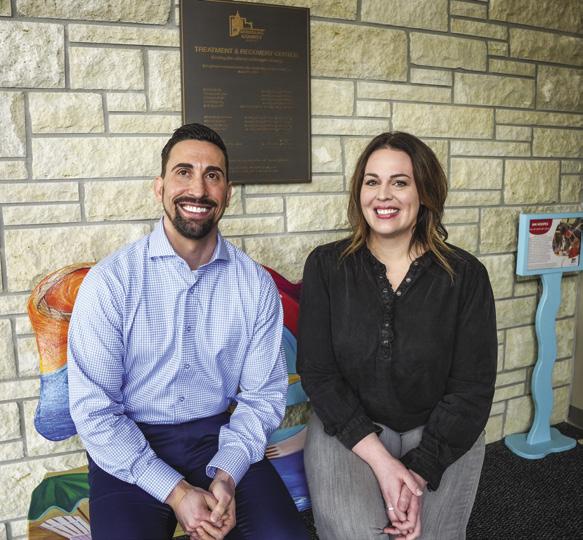
Ryan Sztorch is senior director of Crisis Services at the Center. As part of his role, he works closely with the TRC team.
Sztorch also oversees the Center’s Mobile Response Team (MRT). The team provides crisis assessment, intervention and stabilization services to people at the specific location where the behavioral mental health crisis is occurring.
“Expanding our crisis continuum is needed, exciting, and I feel motivated and humbled by the opportunity to be a part of this life-saving work,” he says.
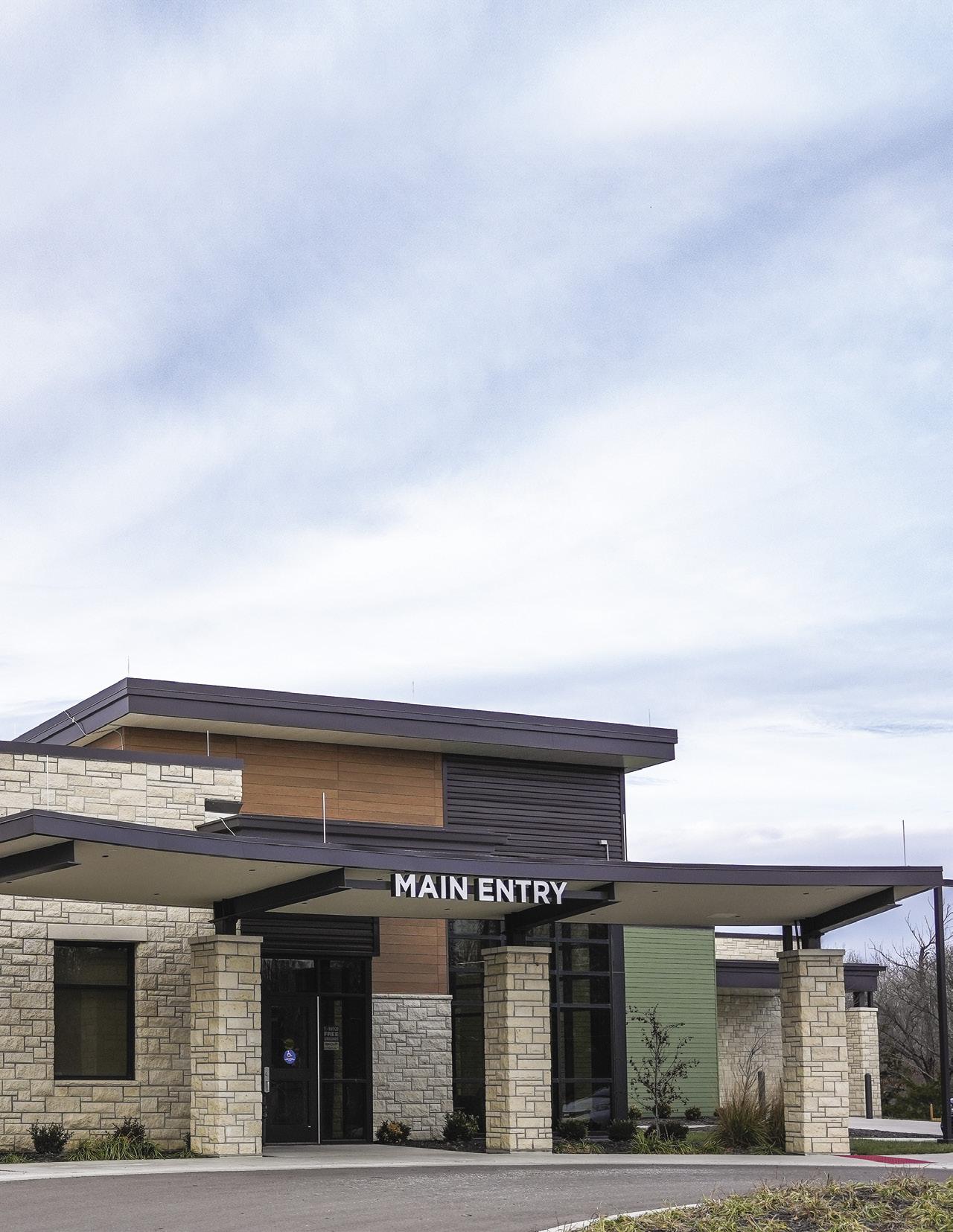 Ryan Sztorch and Bri Harmon-Moore
Ryan Sztorch and Bri Harmon-Moore
If you are experiencing a mental health crisis, seeking emotional support or feeling suicidal, call or text 988, or call the Douglas County Crisis Line at 785-841-2345.
 Members of the Bert Nash Center Mobile Response Team
Members of the Bert Nash Center Mobile Response Team


KATE CHINN OWNER
Express Employment Professionals
What is your organization’s most important commodity or service?
Express Employment Professionals provides staffing and recruitment services to all sectors of business in Lawrence and surrounding communities. Express focuses on building relationships with businesses to provide solutions to recruiting, productivity, turnover, quality and overall profitability for our clients.
16
[ ] SPOTLIGHT
PROFESSIONAL
What is your organization’s most important priority?
Express’ most important priority is respecting people and impacting business within our community. We are a powerful ally in maintaining an efficient workforce in Lawrence. We are plugged into the local job market and what is happening in the Lawrence business community. Building relationships with businesses is the key to our success.
What have been some of the most important aspects of your success?
Having a strong team that believes in our mission of helping individuals succeed has been the most important part of our success. Without this passion for helping others, we would not be where we are today. We change lives, while at the same time helping businesses be able to perform at their highest capacity.
How many people does Express Employment interact with on a daily basis and are responsible to?
With the combination of our associates and the businesses we provide service to, we interact with at least 100 people on a daily basis. Our clients’ needs change daily; the number of touches we make daily is ever-changing.
How do you and your organization make a positive impact on the Lawrence community?
Express Professionals are highly invested in the Lawrence community. Team members are actively involved in The Chamber of Commerce. As incoming Chair for The Chamber Board of Directors, I am actively involved in Chamber activities on a weekly basis. All team members are engaged in networking groups and well as volunteering in and around Lawrence.
What do you see as your personal responsibility and your organization’s responsibility to the community?
Our responsibility to our community is to help individuals find meaningful, fulfilling employment they are passionate about while at the same time providing employers with a strong, capable, engaged workforce that can make a positive impact within their organization. Simply put, we change lives and impact business.
What would you change about doing business in Lawrence?
Lawrence is a great city to do business in. We have had great success over the years. Lawrence businesses are friendly and welcoming. Lawrence has done a terrific job of supporting small business owners, as well. I would not change a thing about doing business in Lawrence. I would encourage anyone who is looking to start a business in Lawrence or relocate to Lawrence to talk to local business owners to meet with The Chamber of Lawrence, get to know your elected officials and just get involved in the wonderful town!
17





Why did you become involved in your chosen profession?
Simply put, I have a passion for helping people. I knew at a young age I would someday be in business for myself. At the time, I had no idea what this would look like. I made one of the best business decisions in 2010 when I bought the Express Employment Professionals franchise in Lawrence. Helping to change the trajectory of someone’s life is powerful. Knowing that we can give hope to individuals looking for employment, whether it be short term or a long-term professional career is tremendously rewarding. I try every day to clear up the misnomer that Express is simply a “staffing agency.” Express is so much more than this. On the surface, we provide jobs; but in reality, we provide hope, stability and partnerships not only our associates but to the business community we serve.
What is the biggest challenge you feel your organization faces?
Lawrence is a big promoter of keeping business local, but I would challenge every business in Lawrence to stand behind this. Use local businesses for your needs. Why look elsewhere when there are local businesses that we can all partner with. As a small business owner, we should all be supporting each other in our efforts to keep business local. It is discouraging when I hear of businesses seeking help outside of our city. Not only this is my challenge, I feel it is every small business owner’s challenge in Lawrence.
What do you foresee as being the biggest challenge for the future for Express Employment?
With business, especially manufacturing becoming more automated, Express will be expanding our reach into more skilled-trade careers as they relate to automation and robotics. We will partner with our local manufacturing companies and technical colleges to uncover the upcoming needs and trends of the future. I don’t see this as a challenge to Express but as a way to differentiate ourselves in our market. This will require asking questions and finding a solution. We need to realize that with change and challenges, there will be bumps along the way, but how we overcome these challenges will only make us more resilient. p
19
Kate Chinn and her team from Express Employment Professionals, recipient of the 2023 Lawrence Business Magazine Woman-Owned Business Foundation Impact Award
SAFETY IS TOP PRIORITY
Lawrence security companies work hard to keep local residences and businesses secure, offering products and services that lead to safer neighborhoods and instill a sense of calm in community members.
by Tara Trenary, photos by Steven Hertzog

When it comes to safety, both in the home and the business, it should always be a top priority. Having a safe environment in which to both live and work not only helps protect your home or business, it also deters would-be criminals and creates a safer neighborhood for everyone around, among many other advantages.
“Home and business security is important to protect people, deter criminals, provide peace of mind, potentially save on insurance costs, enable remote monitoring and ensure compliance with regulations,” explains Ryan Kruse, president of Select One Security and Communication, and Select One Safety and Fire. “Investing in security measures can help create a safer and more secure environment for individuals and businesses.”
According to the August 2023 U.S. News and World Report article “Why Get a Home Security System,” a security system offers protection for loved ones and property, as well as peace of mind to homeowners. “While property crime has consistently declined from 2011 through 2020 by more than 30%, according to the FBI, it’s still smart to invest in protection for your home. Today’s home security systems go beyond protection with home automation features that can add convenience to your life and help to conserve energy for lower bills,” making the cost of these systems more attractive.
On the business side, security is crucial for survival, according to Business.com’s Jan. 2024 article “Why Business Security Is Important for Growth.” Many small and midsize businesses “struggle to find the time and resources to give business security the attention it deserves. Every time a business suffers an intrusion, theft or damage, fixing the situation costs money.”
And, if security incidents happen too often, they can threaten a company’s well-being, the article adds. “Your business’s future depends on your ability to protect your assets, people and reputation from bad actors, both internal and external.”
Luckily, Lawrence offers an array of companies specializing in different areas of security. Each offers specific services, including wireless and nonwireless home safety equipment, mobile apps, surveillance cameras, perimeter detection devices, motion detectors with multiple features, monitored life safety systems, security panels and smart home systems, among a long list of other offerings.
20

Public vs. Private Safety
Public safety within communities is important, providing a safe environment for people to live, work and play. Government agencies, organizations and individuals come together to ensure that their citizens and communities are secure. Public safety not only reduces crime and protects community members and their properties, it also provides economic benefits, such as increased investment in the town, more tourism and additional social benefits, such as increased trust and cohesion within the community. People feel safer and more secure, and that helps foster trust and cohesion within a community.
Shayne Kahle, operations manager for Rueschhoff Security Systems, explains: “I have always made safety and security a priority for my family, neighbors and community. Public safety is being aware of your surroundings. Public safety has far-reaching impacts on a community’s physical and mental well-being of their residents. A safe community is a healthy community.” He recommends getting involved with public safety meetings held by local police and fire departments, if available.
Select One’s Kruse agrees. “Providing peace of mind to our customers is in hand in our industry with crime prevention, working with law enforcement and working with our public safety offices servicing our community.”
Going hand in hand with public safety is the safety of private homes and businesses. According to The Zebra, the nation’s leading independent insurance comparison site, in its eye-opening January 2023 Burglary Statistics Report: In the United States, there are 2.5 million burglaries annually, 66% of which are home invasions; the FBI reported 1,401,840 burglaries, with 57.5% of all burglaries involving forcible entry in 2017; a break-in occurs every 26 seconds; every 15 seconds a home burglary occurs; homes without a security system are 300% more likely to be broken into and burglarized; 46.9% of people don’t have a home security system installed in their home; 83% of would-be burglars check for the presence of an alarm system before attempting a break-in; 34% of burglars use the front door when breaking into a home; and police solve only 13% of reported burglary cases.
Kahle says the biggest hurdle Rueschhoff faces is the client being reactive and not proactive, meaning the customer takes action after a burglary or fire has already happened instead of before. One example, he explains, would be a client who is building a new home. Rueschhoff likes to have the infrastructure in place for burglary and fire protection. “I think people would be surprised how affordable it is to have a home prewired for a system. The homeowner also can take advantage of insurance discounts when having a monitored system.”
21
A Treasured Community Staple
Since 1976, Rueschhoff Security Systems has protected generations of families and businesses in Lawrence and the surrounding areas. The company specializes in residential and commercial burglary, fire, access control systems, as well as camera systems. It services most of northeast Kansas, as well as Missouri and other states. It also owns and operates its own Central Station Monitoring Center, which functions as a support system for critical event management devices.
The company works with a diverse client base, including residential, commercial, state, government and industrial, and offers services such as Intrusion (burglary) systems; Intrusion system inspections; fire systems; fire system inspections; access control; camera systems; home automation; central vacuum systems; and local monitoring. Its sister company, Rueschhoff Communications, provides answering services for doctors, plumbers, electricians, etc., as well as locksmithing.
Rueschhoff has 30-plus mostly full-time employees, Kahle says. They work in a variety of specialties, including administration, accounts receivable, accounting, technical support, customer support, information technology (IT) and as field technicians, locksmiths and dispatchers.
“Sometimes it is a challenge to find the talent that we require,” he continues. “Rueschhoff is very selective when hiring. All of our potential candidates go through state and federal background checks. They are also drug-screened. In our industry, we handle sensitive and private information, and we take that responsibility very seriously.”
Kahle says some Rueschhoff employees are college graduates or have a degree from a technical college, which can be important in some positions. “We provide in-house and manufacture training and certifications for our field technicians, as well as ongoing education and training. It is important to keep our technicians and sales staff certified and up to date with the latest technology, as well as city and state codes.”
Rueschhoff always analyzes whether a project would be a good fit, he explains, not only financially but also for the long term. “Our goal is to not only provide a service for a client, but it is very important to establish a solid long-term relationship. Currently, we have several commercial projects with local health-care agencies as well as working with KU.” These projects include burglary, access control, camera systems and fire protection systems, he adds.
Along with providing invaluable services in safety to the community, Rueschhoff also serves by donating or offering services to businesses and programs, Kahle explains. “We stay active with The Lawrence Chamber as well as the Lawrence Home Builders Association. We also provide live webinars on community and neighborhood safety.”
He says the staff donates time and services to community programs, as well as working closely with the Lawrence Police Department providing information that might help solve crimes and helping the Lawrence Fire Department make sure homes and business are safe.
“Lawrence is great in many ways,” Kahle says. “There are so many opportunities to grow our business here. Lawrence has many great contractors that choose to invest in Lawrence, and that give Rueschhoff the opportunity to be involved in their projects.”
Chuck Schulz, Heartland Community Health facilities manager, has worked with Rueschhoff for about three years. He says the company provides 24-hour monitoring services for fire and security, as well as performs Heartland’s annual security inspection. They also handle access control and all locksmith needs. “So far, there has not been a problem that we have not been able to work through together, from custom-designing security needs to custom locks.”
Heartland and Rueschhoff have a continuous relationship, sometimes weekly depending on the scope of the issue at hand, Schulz explains. “The gentlemen on the security side and I talk frequently; they are always happy to lend a helping hand. They set the bar extremely high—their customer service in my opinion is top-notch. All the employees are knowledgeable and superfriendly.”
First-Class Communications
For more than 10 years, Select One Security and Communication, a “full-service, low-voltage and technology company,” has offered Lawrence and the surrounding area the latest and greatest security, automation, apps and software to hit their hands each day, explains Select One president Kruse, who’s been in the security industry for more than 20 years. “We have to be on the cutting edge to give our customers what they need and demand.”
22

S E C U R I T Y & C O M M U N I C A T I O N S


houses and small apartment buildings. We have been out at the KU (University of Kansas) Innovations newest building now for two years running data wiring and CCTV cameras as different medical and science companies rent out space.”
The company also has a multifamily project in Omaha and several multifamily and commercial buildings in Olathe, Midtown, Mission and Shawnee, in Kansas City. “We would rather manipulate too much work than no work at all,” he adds.
Giving back to the community is also important to Select One and its employees. “We help many of our nonprofit organizations in our community by providing some of our services at no charge or lesser charges to help protect their investments,” Kruse explains. “We also work with our local police and fire departments to provide video and real-time events through our customers.”
Select One employees are active in the community through Junior Achievement of Douglas County, the Boys and Girls Club, Lawrence Habitat for Humanity, Just Food and the Ballard Center, he continues.
Also, “Having KU in Lawrence creates a favorable environment for our business by increasing demand, offering diverse security needs,” Kruse adds. “It provides a partnership and contributes to our local economy. We understand and cater to the specific needs of our KU population to maximize our potential.”
24
Ryan Kruse, owner of Select One Security
Standard Beverage has partnered with Select One Security on various project needs, including lowvoltage work, access control, facility security, as well as video surveillance. Trent Glass, Standard Beverage senior vice president of operations, explains: “We consistently collaborate with them on ways we can improve current systems, as well as future projects coming down the pipeline. We typically have three or four projects a year that we utilize Select One for.”
Glass says the company’s service level is first class. “They listen well to our needs and provide seamless solutions that deliver results. The Select One team is extremely knowledgeable on not only their business solutions, but they also understand the needs of my business and leverage that knowledge to provide best-in-class results.”
He says he likes that Select One is a communitybased company that has consistently exceeded his expectations and has provided “leading-edge, actionable solutions to protect our company and employees. Select One Security certainly has the talent, creativity and expertise to meet your needs.”
Tech, Old and New
Being in a very technical industry, the hardware and software used is always changing, Rueschhoff’s Kahle explains. We make sure that our employees are provided with the necessary tools and training to keep up with the always-evolving technology.
In the past 10 years, “The hardware that is used in the field is not the same as it was … Most all of the hardware is now software-driven. This has been a plus for Rueschhoff and our clients,” he continues. Updates, programming changes, etc., can now be handled in a fraction of the time and, in a lot of cases, remotely.
Kruse agrees. “As with most things we deal with on a daily basis in our personal lives, our business has been enhanced by smartphones and phone apps,” he says. “We have built-in analytics on cameras instead of motion activation for much more true video. We have facial recognition software for access control and letting people in buildings. Social media has helped get new product information out to the



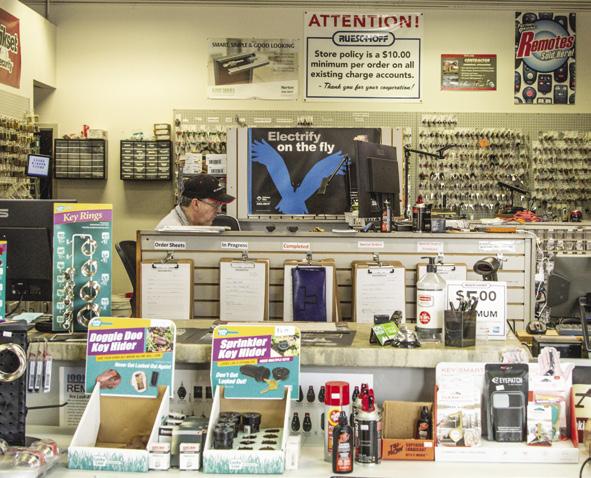
Safe and Secure
26
Warren White and Shayne Kahle, of Rueschoff
Shayne showing a customer the various options in their showroom
Accessories in the showroom at Rueschoff



Hedges helps investors find excellent RENTAL HOMES! Ask us about our investment property finding service.
ON FULL

An invaluable local agency, Douglas County Emergency Management educates the community, plans for varied situations and assembles support systems for possible large-scale emergencies.
by Emily Mulligan, photos by Steven Hertzog
ALERT

Ideally, when an emergency occurs, local residents won’t respond in a way that looks like the old cartoons: people running every which way screaming and arms flailing.
Hoping that people respond calmly isn’t enough, though. Educating people ahead of time, providing resources for them to turn to and planning, planning, planning at the times when there is not an emergency can help ensure that chaos does not ensue.
One agency in Douglas County that unites people who spend almost every waking moment (and likely even some sleeping moments) doing all of the above is Douglas County Emergency Management (DCEM).
“No one wants to think about the bad things that can happen,” says Jillian Rodrigue, deputy director of DCEM. “We do a lot of worst-case scenario planning so that our plans and procedures are better.”
The team at work in the Douglas County Emergency Management Center

DCEM staff and volunteers are not typically first responders in their planning roles. Rather, they either jump into action when a large-scale emergency happens, such as a severe weather event, or they are contacted when local first responders in the field are stressed or overwhelmed by the number or severity of emergency calls.
“We’re partners—we don’t do it to them; we do it with them, helping people understand that everybody has a role to play,” says Mike Russell, director of the department of Environment, Health and Safety at the University of Kansas (KU), and longtime DCEM board member.
DCEM assembles the support systems for any and every type of emergency that might take place in Douglas County; it has staff, technology and budget to support resources and communications that need to be deployed.
“We help the helpers. I like to say we conduct the orchestra. They know how to play the instrument, and we stay on time, putting structure over the top, with all of us starting and ending together,” Rodrigue explains.
What types of emergencies does DCEM prepare for? The short—and rather sarcastic— answer is “yes.” In other words, DCEM has formulated plans for just about every type of emergency imaginable that has the potential to happen in Douglas County, including tornadoes/severe storms; flooding; mass casualty events such as shootings or fires; large-scale power outages; hazardous materials spills/leaks; virus outbreaks; and even cyberattacks. Not all of the emergencies DCEM has plans for are negative events: The county’s NCAA Men’s Basketball Tournament plans for Downtown Lawrence, for example, fall under DCEM’s purview, as did the 2022 KU National Championship parade.
“Our program is risk-based. We plan and train for incidents based here—we’re not training for tsunamis, for example,” Rodrigue says.
Jillian Rodrique, deputy director of DCEMDouglas County Emergency Management Center
Planning, planning and more planning.
Preparedness, mitigation, response and recovery are the four traditional stages of any emergency. Because larger-scale emergencies thankfully do not occur all that often in Douglas County, DCEM staff, board and volunteers spend most of their time planning and updating plans for a variety of types of emergencies. The plans lay out detailed steps for each of the four stages, and they include precise communication tactics with backup communication plans in case of power outages or communication network outages. Plans also either mobilize resources of vehicles and people who are first responders, and/or they alert particular agencies to prepare specialized equipment or supplies for implementation or distribution.
Rodrigue says that one of the main goals for big disasters is planning to ensure continuity of operations, still providing essential services no matter the circumstances.
Staff and volunteers with the DCEM board and community partner agencies are constantly on call in case of an emergency.
“There are a lot of people on the board with the same mindset. We’re at the beck and call 24/7/365,” Russell says.
Being on alert and having people on call is not intended to generate fear or anxiety, to the contrary, she adds.
“In making these plans, we tend to regain some control. That helps to take a little bit of stress and anxiety out of the disaster. Having an action people can take allows them to take the control back,” Rodrigue continues.
Protecting human life and safety, and providing information to the public about how to protect themselves shows people how to respond to a local emergency, Russell says.
“Trying to be aware of the various hazards out there, we want to inform people; we don’t want to scare people,” he says.
Once the sky clears, either literally or metaphorically after a disaster, is when recovery begins. Recovery plans can be slow to unfold, depending on the circumstances of the disaster.




32
top to bottom
The Douglas County Alternate Emergency Operations Center (EOC) was activated to support first responders through the coordination of information and additional resources as they were fighting numerous grassfires in Feb. 2022.
Pictured LDCFM and EM staff monitoring severe thunderstorm warnings to keep first responders in the field aware of the approaching hazard.
An EM Staff member (Erin Huneke, Management Analyst) shares information in NWS Chat during the Statewide Tornado Drill.



Arts Center and many private-sector businesses,” she says. “A lot of other jurisdictions could not fathom how we came together across the community.”
Through both his job at KU and his roles with DCEM, having served as DCEM board president 10 times, Russell says he values both the cohesiveness and effectiveness of the agency.
“I’ve seen and experienced a lot of emergency management boards in the state. I’ve never seen or been involved with one that works as well as this one does,” he says.
DCEM staff and volunteers rely on information about best practices from around the country and the state to keep their plans updated and prepared. At times, local first responders and emergency managers are called upon to assist in regional disasters and vice versa. Emergency planning is a collaborative undertaking, and information is shared openly among agencies and peer networks.
Certain regions are more susceptible to more frequent disasters in certain categories, so DCEM consults those disaster and recovery plans that may apply to local situations. For example, states where hurricanes occur tend to have the best plans for things like debris management, Rodrigue explains, so it is most efficient and effective to adapt those tried-and-true techniques and practices locally.
What’s Next?
What does the future hold for emergencies and disasters? Well, more of both, of course. With evolving technologies, politics and weather, DCEM is always analyzing new types of potential emergencies that can strike locally.
Rodrigue says DCEM is evaluating all of its disaster plans to account for the potential of artificial intelligence either being involved with or generating an emergency. Trainings and exercises incorporate new and up-and-coming technologies both for the genesis of emergencies and for the response.
“We did a field exercise last summer simulating a disaster with a hazmat transport. In the exercise, we used drones that were capable of reading the paperwork inside the cab of a truck,” Russell says. There would be no need for people or first responders to enter the dangerous and potentially fatal scene if the drones can safely access that type of information instead.
Recently there has been an increase in discussions about emergencies that result from political and civil-related violence, and how to respond accordingly, he adds.
DCEM is examining its network and processes for providing mental health services to first responders and emergency managers, as well as working to incorporate mental health support into its plans, Rodrigue explains.
Unfortunately, there is no way to keep Douglas County residents’ lives completely disaster-free.
“Emergencies and chaos will happen. How much impact they’ll have depends on our response to them,” Russell says. p
34
The Douglas County Emergency Operations Center (EOC), led by Emergency Management, was fully activated following the May 28, 2019 tornado to support immediate needs from field operations and the community as well as begin recovery planning.

B I G C I T Y
A B I L I T Y
w i t h h o m e t o w n v a l u e s





BLAZING A PATH FORWARD
Lawrence-Douglas County Fire Medical continues a progressive track as it leans on the past to launch itself into the future.
Fire Medical Training conducted by LFD photos by Taylor Mah
by Nick Spacek, photos by Steven Hertzog and Taylor Mah

First formed in 1859 as a volunteer fire department, disbanded in 1862 because of the Civil War and officially incorporated as a 10-member, full-time agency in 1915, Lawrence-Douglas County Fire Medical is a department full of history.
Walking into the administration offices attached to Station No. 5, at 1911 Stewart Ave., one is greeted by an array of displays documenting that historical legacy, curated by unofficial department historian Dylan Brown. The displays show the department where it’s been and help it determine where it’s going, says Lawrence-Douglas County Fire Medical Fire Chief Rich Llewellyn.
“There wasn’t actually a fire department here when Quantrill’s Raid occurred,” Llewellyn says. “I like to think that we pioneered women in the fire service, because it was women who were putting out the fires that were left after Quantrill disappeared from here.”
It’s nice to have that touchstone to the past, he continues, to be able to look and see where they’ve come along.
“We’ve been progressive,” the fire chief explains. “Early in our history, we had one of the first motorized ladders trucks that was anywhere in the Midwest, and folks came around from all over to see it. As we move in the future, it’s nice to recognize that we have been progressive in the past, and we can continue with being a progressive agency.”
Any agency can encounter challenges going forward. When it comes to recruitment and retention, one might think a college town would provide a regular group of new graduates; but the constant burn and churn of the city’s population offers its own issues.
“Speaking to that specific thing, we haven’t seen a ton of relation with KU graduates,” says McKenzi Ezell, the Fire Medical data analyst and accreditation manager. “That is something that we’ve talked about—trying to get more into that realm and being more visible and making those connections.”
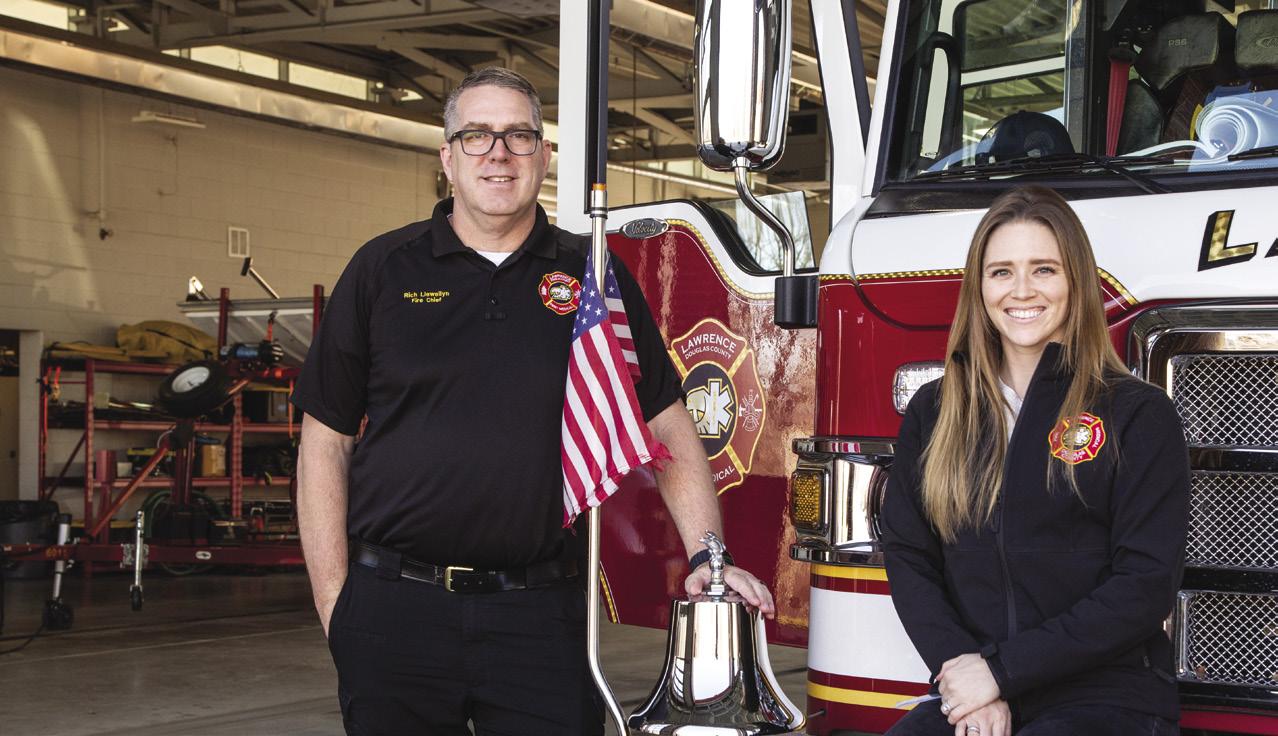
“We’re finding—and I don’t think Lawrence is isolated in this, it’s a phenomenon that’s occurring across the country—that fewer folks are interested in getting into the fire service,” Llewellyn adds. “We’re not seeing hundreds of people apply for positions. We’re seeing dozens of people apply for positions.”
Lawrence-Douglas County Fire Medical has to be more intentional in its recruiting, he continues. This includes reaching out to the University of Kansas (KU) and showing up at career fair events, as well as reaching out to Haskell University to try to leverage the relationship with those recruiting pools.
“Those are folks we want,” Llewellyn emphasizes. “We want people who have been here in Lawrence and want to continue to remain in the area and serve the city.”
Ezell agrees. The department is unique in that it does emergency medical services countywide and firesuppression services in the city and Grant Township.
“I think that gives us a unique … perspective that it’s not just a fire department, but it’s truly a fire-medical service,” she continues. “We’ve really honed in on the medical side, especially with our transport and transfer medic units.”
Planning Ahead
38
Lawrence Fire Chief Richard Llewellyn and McKennzi Ezell, CPM-Fire Medical Data Analyst



 Live burn Training conducted by LFD and other training photos by Taylor Mah
Live burn Training conducted by LFD and other training photos by Taylor Mah

When there is the Maple Leaf Festival in Baldwin City, Lawrence-Douglas County Fire Medical can anticipate it’s going to have extra work in Baldwin City and plan how to access those patients. Staff works very closely with partners and other agencies, such as the Baldwin City Fire Department in this example.
“We have to know where they’re going to have patients, how we can access them, are they going to bring them to us, do we need to go to them?” Llewellyn says. “Those conversations happen in advance. It’s just a recognition of the complexity that we face.”
When determining who goes where, Ezell says all units in Douglas County are dispatched through the Douglas County Emergency Communications Center, which is based on AVL (automatic vehicle locator).
“If a call is in a certain part of the area, say the southwest part of Douglas County, it’ll dispatch the closest unit,” she explains, adding that Lawrence-Douglas County Fire Medical has two stations out in the county with medic units: Station No. 12, which is in the city of Eudora, and Baldwin City’s Station No. 11. “Those units don’t just stay in their little area. They can go wherever.”
Blurred Lines
Being able to go wherever becomes important when medical responses are needed where city limits and county lines merge. The Panasonic plant in DeSoto, an industrial facility that will construct batteries, could pose a problem with chemicals on an industrial scale. Many fire departments in Douglas County are closer to that factory than those in Johnson County.
Complex incidents tend to blur jurisdictional lines because of the potential for significant resource needs, Llewellyn explains, and so building a factory becomes a spiderweb of issues with which LawrenceDouglas County Fire Medical might have to deal.
“One little twinge on a part of the web is going to impact the rest of the system,” he adds. “If we do have something that’s going here in Lawrence, and we’re bringing in partners from other entities to assist us, it’s creating issues with those other entities as far as them needing more resources.”
Llewellyn has been fire chief since 2022, having previously been assistant chief of administration for the Everett Fire Department, in Western Washington. He says when he first got here, one of the challenges in the organization’s worldview was that it was very focused on what’s happening here in Lawrence and in Douglas County. He has been trying to expand that to incorporate other entities, identify mutual aid partners and sign agreements with them.
“We are working very diligently on finding partners who we can both help and who can help us,” the fire chief says, pointing to other fire and EMS agencies as those that have usable resources or might need resources that Lawrence-Douglas County Fire Medical can provide.
40
Front row l-r: Jacob Cruse, Michael Mathews, Aaron Davenport , Zoe Mays, Trey Strohm
Back row l-r: John Dines, Adam Eudaly, James Barkley , Jack Dolan, Rich Llewellyn , Brian Trigg , Patrick Schneider, Justin Temple


Ezell highlights the work the department does with city and county agencies, saying there are many people in the department who go to planning meetings for new builds, such as the Panasonic plant, along with those who specifically work with KU or KU Athletic events, as well as Douglas County Emergency Management hosting workshops to start planning for some big events that could happen.
“I think that those workshops really facilitate the time and the coordination for all of these agencies to come together to start brainstorming some of these things and to see how that web can be impacted,” she emphasizes, explaining that all of these interagency meetings have attendees discussing resources not only in Douglas County but outside of Douglas County, as well.
“We’ve experienced a profound amount of change in the last five years in this industry, and so we do have to stay on top of new technology, new techniques,” Llewellyn says, pointing to COVID, which created conditions the department had to address, including changing orders and procedures on a weekly and sometimes daily basis. “We do like to look out and see what’s available and makes sense for us to bring in.”
Looking to the Future
One recent program Lawrence-Douglas County Fire Medical implemented is called PulsePoint, a crowdsourced app that allows people with EMS training or medical training and the ability to do CPR to respond to CPR events in public places.
“If you’re sitting here, and there’s somebody (who) needs CPR across the street, and you have PulsePoint, you’re gonna get a notification,” Llewellyn explains. Additionally, the PulsePoint app provides public notifications about what your fire department is doing. “So if you hear a siren going by, you can pull up PulsePoint, and you can see, ‘Oh, they’re going to a medical incident on Sixth Street.’ Those technologies are allowing us to not only respond better, allowing the community to be involved, but also getting our message out there.”
No more asking “What does Lawrence-Douglas County Fire Medical do?” “What are they going?” “Where are my tax dollars going?” With PulsePoint, you can see it in action.
“We are accredited, and accreditation really focuses on continuous improvement for fire service and fire medical service,” Ezell adds. “That process not only allows us to take a deep dive to look at ourselves and be reflective, but then also to look at other agencies regionally throughout the United States and then also internationally, to see what’s working where and for different communities.”
It’s been really beneficial to have people be a part of that process, she continues, because Lawrence-Douglas County Fire Medical has a lot of in-house trainers who go out and participate in as well as conduct training, and are able to bring it back to Lawrence and Douglas County, and implement what they’ve learned.
“It might not necessarily be tied to technology, but more of an advancement or awareness of technology that’s coming up,” Ezell adds, while also pointing out that coming soon is something that goes back to the technology previously discussed: the fire truck.
“Hybrid fire trucks are on our capital improvement plan,” she explains. “We have projects related to the replacement program of our fire trucks going from a diesel engine to a hybrid engine that has the ability to run off the electric side and then, in default, if it needs to go to the diesel engine, (it’s) able to do so.”
One thing the city’s also focusing on is standardizing citywide. Lawrence-Douglas County Fire Medical is working in coordination with the city to figure out what infrastructure will be needed to support these electric or hybrid fire engines and planning for future stations.
“The next five to 10 years … we’re focused on delivering a high-quality service,” Llewellyn says of future plans. “We want to make sure we’re able to respond to fires in a timely manner. We want to make sure that people live long and healthy lives, and that’s both our fire side and our EMS side. One of the major initiatives that we’re looking at for the future is our station locations.”
He explains that the department is behind in getting new fire stations, with one fire station that’s road-mapped to open in 2027-28 and sites currently being discussed to build it.
“We need some more stations around town, and we do have some aging infrastructure,” says Llewellyn, looking ahead. “We’re looking at building new facilities and replacing some older facilities. That’s going to be big for us in the next 10 years.” p
42



THE RIGHT WAY TO SERVE
by Bob Luder, photos by Steven Hertzog
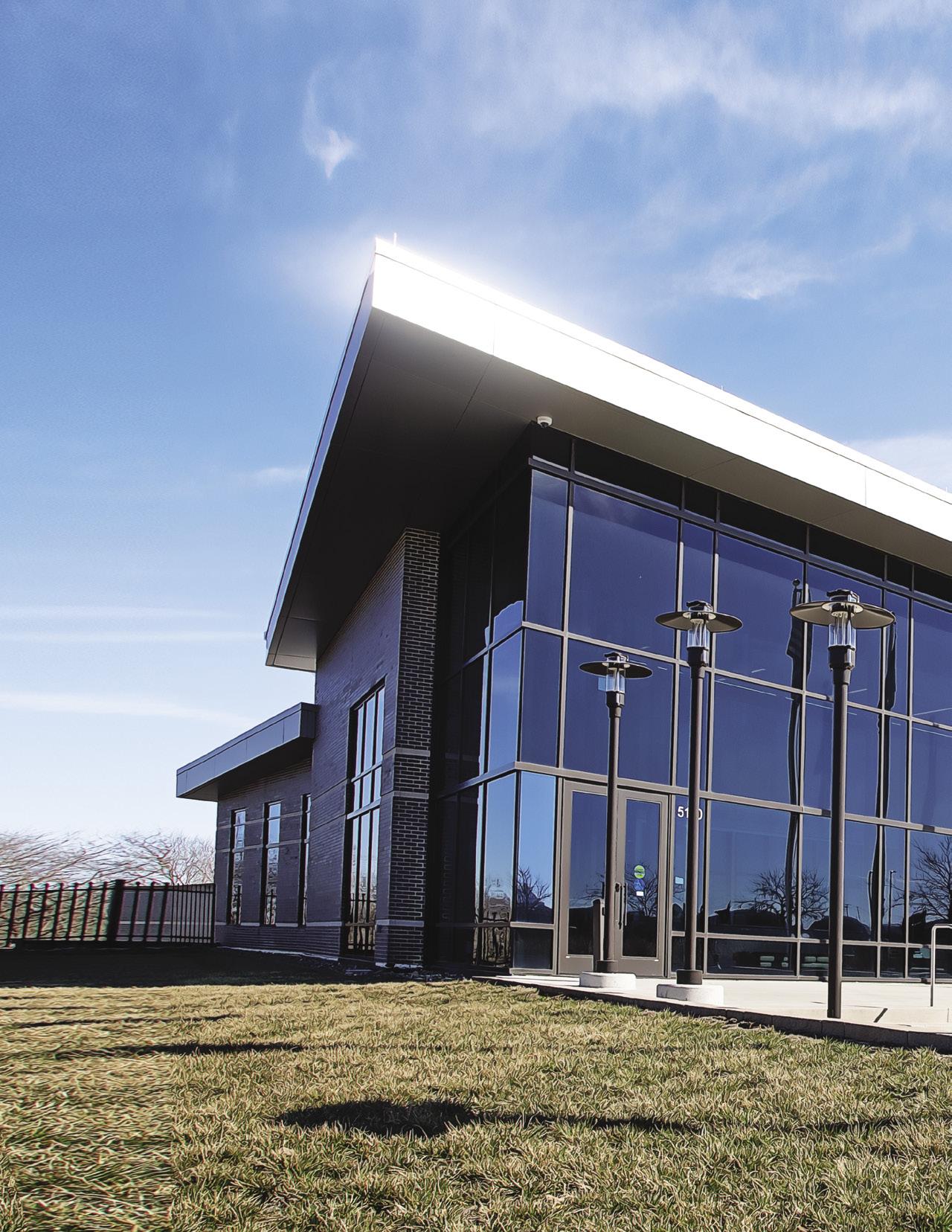
Becoming a fabric of the community and guided by its residents, local police departments join together using a team approach to police the community the way it wants to be policed.
Anthony Harvey Jr. grew up in East Lawrence, in an area where many of his neighbors held a rather negative view of local police. And that’s putting it nicely.
“We were not fond of police,” Harvey Jr. says. “We didn’t know about them. There were not many interactions. The sheriff’s department’s gas pumps were located by our house, so that was really the only time I’d see them. I also grew up seeing bad things on the news all the time.”
One day before his 10th birthday, Harvey Jr. witnessed police officers come to his house and arrest his father, adding further to his skepticism of the men in blue.
“I saw my hero taken away by the police,” he says. “It made me feel like the police were out to get us. It was just seeing situations like that and not understanding it.”
Harvey Jr. says those experiences drove him into some dark times. But during his fourth- or fifth-grade year—he can’t remember which—a single interaction changed the course of his life.
Myrone Grady, a then Lawrence police officer serving as a school resource officer (SRO) at South Junior High School, visited Harvey Jr.’s grade school and spoke with a youngster who had never had a oneon-one interaction with an officer. And Harvey Jr. listened.

“I found out he was just a regular dude like me,” he says. “He instilled in me the importance of knowing who you are and who you want to be.”
Harvey Jr. says he stayed in communication with Grady, now a lieutenant and executive director of diversity and community engagement with the Lawrence Police Department, on an almost-daily basis. When he got to middle school, he met more officers, rarely talking with them about law enforcement but instead focusing on life and realizing potential—them showing him they cared.
Those interactions led to Harvey Jr. completing a degree in criminal justice at Newman University, in Wichita. Today, he’s Officer Anthony Harvey Jr., of the Lawrence Police Department and the embodiment of what he used to be so suspicious.
“I just knew I wanted to be the cop that I needed back then,” says Harvey Jr., who also serves as an assistant basketball coach at Lawrence High School. “I want to be that cop who wants to get together and go to lunch and talk, give kids the opportunity to be who they are.
The new Lawrence Police Department Headquarters

“I’m just blessed I met Lieutenant Grady,” he adds. “He’s like every father figure I’ve met in my life. And he changed my perception of what it means to be a policeman.”
Though he most likely would bristle at the suggestion, in many ways Officer Anthony Harvey Jr. is the face of today’s Lawrence Police Department, an organization with people of varied pasts and a wide array of backgrounds and experiences.
Policing for This Community
Lawrence Police Chief Rich Lockhart, who arrived in town a little more than two years ago, calls his current position his “Goldilocks job.” After 26 years in Kansas City, Missouri, with 310 square miles and a sizeable dose of violent crime, followed by a few years in much smaller Warrensburg, Missouri, he’s found the size of Lawrence to be just right.
Lockhart oversees an award-winning department authorized for 152 officers. The lion’s share of those are patrol units that rotate among four shifts. He also has an investigations division, divided into three specialized units. The general investigations unit covers violent crimes like murder, battery and kidnapping, along with financial crimes. The special victims unit (SVU) works to solve sexual-and physical-abuse crimes with the expertise of two civilian investigators formerly employed by the Kansas Department for Children and Families. The division also has detectives specially trained in gangs and narcotics working in directed investigations. The department’s training division runs its own police training academy, approved by the Kansas Law Enforcement Training Center, at the site of the city’s old police station, on Bob Billings Parkway.
It’s also an extremely diverse department, both in terms of demographics and backgrounds. The department, 13 to 14 percent of which consists of female officers, includes a detective who travels to Canada, Singapore and the
46
Officer Anthony Harvey, Jr and Lieutenant Myrone Grady patrol Downtown Lawrence



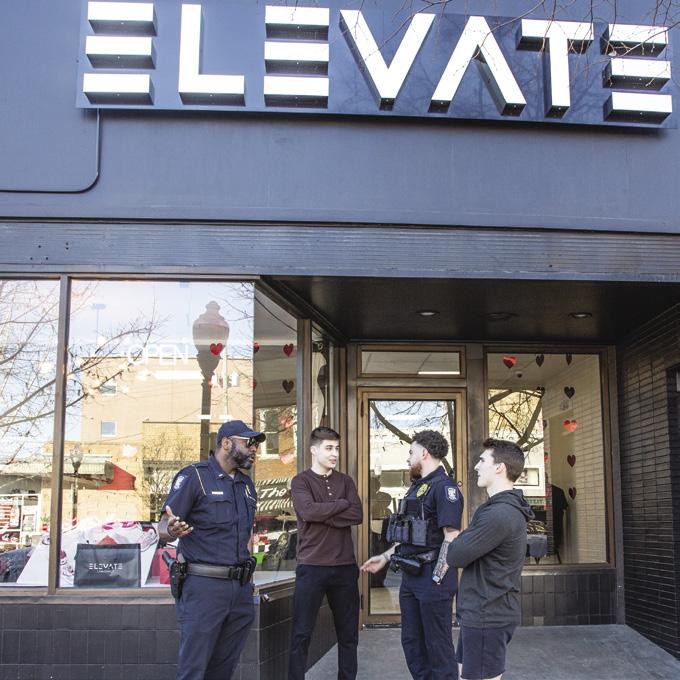
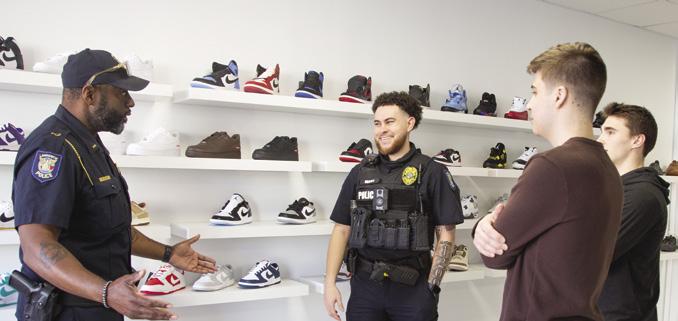
United Kingdom every year to teach forensic video analysis and has a bachelor’s degree in both math and computer science. It also includes a woman with 28 years of experience working difficult SVU cases and a former member of the British military. Also, a corporal about to earn her Ph.D. and a former network TV journalist round out the group.
“The last academy class was one of the most diverse we’ve had,” Lockhart says. “Still, we know we need to work on it. We’re not where we want to be.”
No matter what division, unit, rank or position within the department, Lockhart says the goal is to reach out and forge relationships with those they protect and serve, to become a fabric of the community. He says it starts with the schools and working closely with children, educating them on things like drugs, alcohol and mental health. He promoted Grady to executive director of diversity and community engagement for that purpose. The department also has six SROs, one at each of Lawrence’s two high schools, and one at each middle school.
In fact, the SRO program has been so successful, Lawrence has had the SRO of the year in the state of Kansas each of the last two years.
Lockhart also proudly points to the Lawrence Kansas Police Department’s Handle With Care program, initiated in September 2022, which identifies students who have had police contact outside of school and alerts the school’s SRO to inform the students’ teachers to give them extra care in future interactions.
48
Officers Grady and Harvey enjoy engaging with the Lawrence public here talking with Elevate owner Ethan Bentzinger and friend/employee Wyatt Durland
Police officer Lindsay Bishop and West Middle School Interim Principal Therese Brink Edgecomb spending time with students during lunch



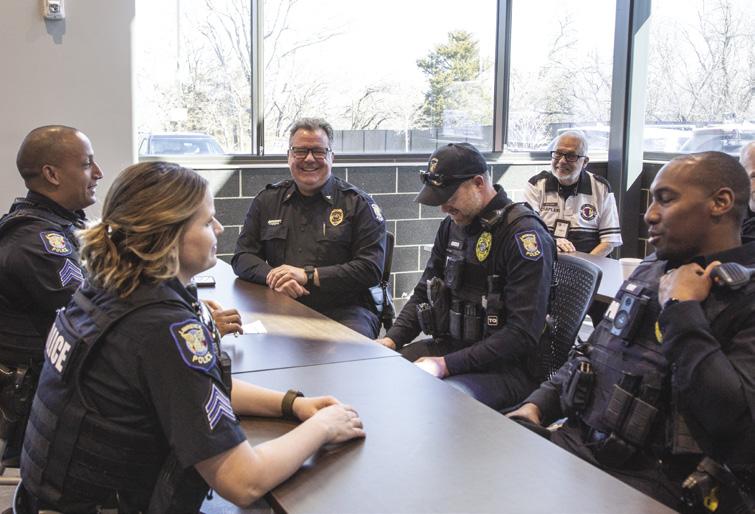


“The beginning of each school year, we do a lot of work with students,” Lockhart says. “In November 2022, we started foot patrols downtown to connect with the business community, make them feel safer and support them.”
Lockhart, who last year was appointed by Kansas Gov. Laura Kelly to the Kansas Commission on Police Officers’ Standards and Training, says sometimes the simple things can go a long way. He allows officers to wear sneakers when they’re out on special community-engagement assignments, because it allows them to relate to young people with whom they might interact.
“It’s all about trying to connect with people where they are,” he adds.
The department also recently implemented a partnership with the national Lights On! Program, in which, instead of writing a ticket for having a headlight or taillight out, they present a voucher to help get it fixed. Lockhart added a teen police academy for ages 14 through 18 to the department’s longstanding police camp for younger kids after seeing the need to build bonds at all ages. Two sessions are planned for this summer. LKPD officers passed out Popsicles at a local swimming pool last summer.
“In the end, this is a people business,” Lockhart says. “We need to police a community the way it wants to be policed. The only way to know how is by getting out and talking to them.”
All in on Community Policing
The University of Kansas Police Department (KUPD) also has put a strong emphasis on community policing and forging strong relationships with the university community, especially since the arrival a couple years ago of Chief of Police Nelson Mosley.
top to bottom Police Chief Rich Lockhart enjoys his daily meetings with his officers Police briefings occur everyday before every shift with the Lawrence Police Mother’s Against Drunk Drivers speak with Lawrence Police about their personal experience’s




For the KUPD, that consistency includes good communication among the department, campus community and its outside partners, which includes LKPD.
In fact, Lockhart says his department’s partnership with KUPD is so good, “it almost feels like one police department. They’ve been a good partner with us.”
Get Out of the Car
Perhaps the real centerpiece to the community policing initiative is the aforementioned Lieutenant Grady, the former school resource officer who took a young, disillusioned Harvey Jr. and helped mentor him into becoming a police officer himself.
Like Harvey Jr., Grady didn’t have the easiest upbringing. Growing up in Merriam, Kansas, he lived mostly with aunts and uncles from the age of 9. He admits he never was much of a student. But football was his salvation, and he ended up playing at Fort Hays State University, where he achieved an bachelor’s degree in social work and master’s degree in political science and justice studies.
He would go on to coach football at Fort Hays State, but he says once he became a father, economic realities forced him seek another career. Becoming a police officer seemed a natural move—but only as the kind of police officer he envisioned for best serving his community.
“The biggest thing I’ve always tried to do is establish relationships,” says Grady, who’s in his 21st year with the LKPD. “I don’t believe in the ‘us versus them’ mentality, because for most of my life, I was them.
“To be an effective police officer, you have to get out of the car,” he continues. “We didn’t have computers in the cars when I started. That can take away the human side of policing.
“You’ve got to know people. That’s the only way to get out and know the community,” Grady adds.
One of Grady’s primary tasks is directing the SRO program, which has produced the last two Kansas SROs of the Year. Grady himself was SRO of the Year in 2011.
“We have great people in the SRO program,” he says. “I think it’s a great microcosm of the department. There’s a great diversity of people. And it allows patrol officers to do their jobs a little easier, because SROs have forged relationships.”
52



 KU Police Chief Nelson Mosley and KUPD Deputy Chief James Druen
KU Police Chief Nelson Mosley and KUPD Deputy Chief James Druen
Incentivizing Good Behavior
Officer Lindsay Bishop is a School Resource Officer at West Middle School who knew she wanted a career that made a difference in people’s lives. For the last 17 years, she has served the families of Douglas County as a social worker then a police officer, devoting most of her career to investigating crimes against children.
She says being an SRO is probably the most rewarding position she’s held, but she’s much more than an officer patrolling a school. She’s also a peer, a counselor, and many times just a friend who listens.
Bishop says her approach to being an effective SRO is three-pronged. Of course, there’s providing safety and security to students and staff. But there’s also educating students and staff on things such as internet safety and career paths. Finally, there’s the relationship building, being a trusted adult students can lean on when in need.
“Kids often remember interactions with police officers their whole lives,” says Bishop, who remains a licensed social worker. So when she’s not patrolling the school, she often can be found playing a hand of UNO with students or serving pizza. She’s even performed mock interviews with students. She also created the “Caught You Doing Some Good” award. It comes with police cup, candy, prizes and a certificate, and the student gets a picture with Officer Bishop for the parent newsletter.
“My job to protect the students is a just-in-case job,” Bishop says, “and I train for that and am willing and ready to risk my life for these students every day. My favorite part, however, is watching them take the risks—playing a sport, participating in organizations like Model UN—putting themselves out there when they don’t have to. Adults just don’t behave like this.
“It’s amazing to watch day after day. It’s inspiring, and it’s inspired me,” she says.
Equally inspiring, Bishop adds, is the diversity and accomplishment that lives within the department for which she works devotedly.
“The education and diversity in this department is so amazing,” she says. “There are tons of college athletes. There’s even an aerospace engineer. There are people who were born here and people born in other countries.
“What you bring in determines how you do the job. That’s what makes this a strong place to work,” Bishop says. p


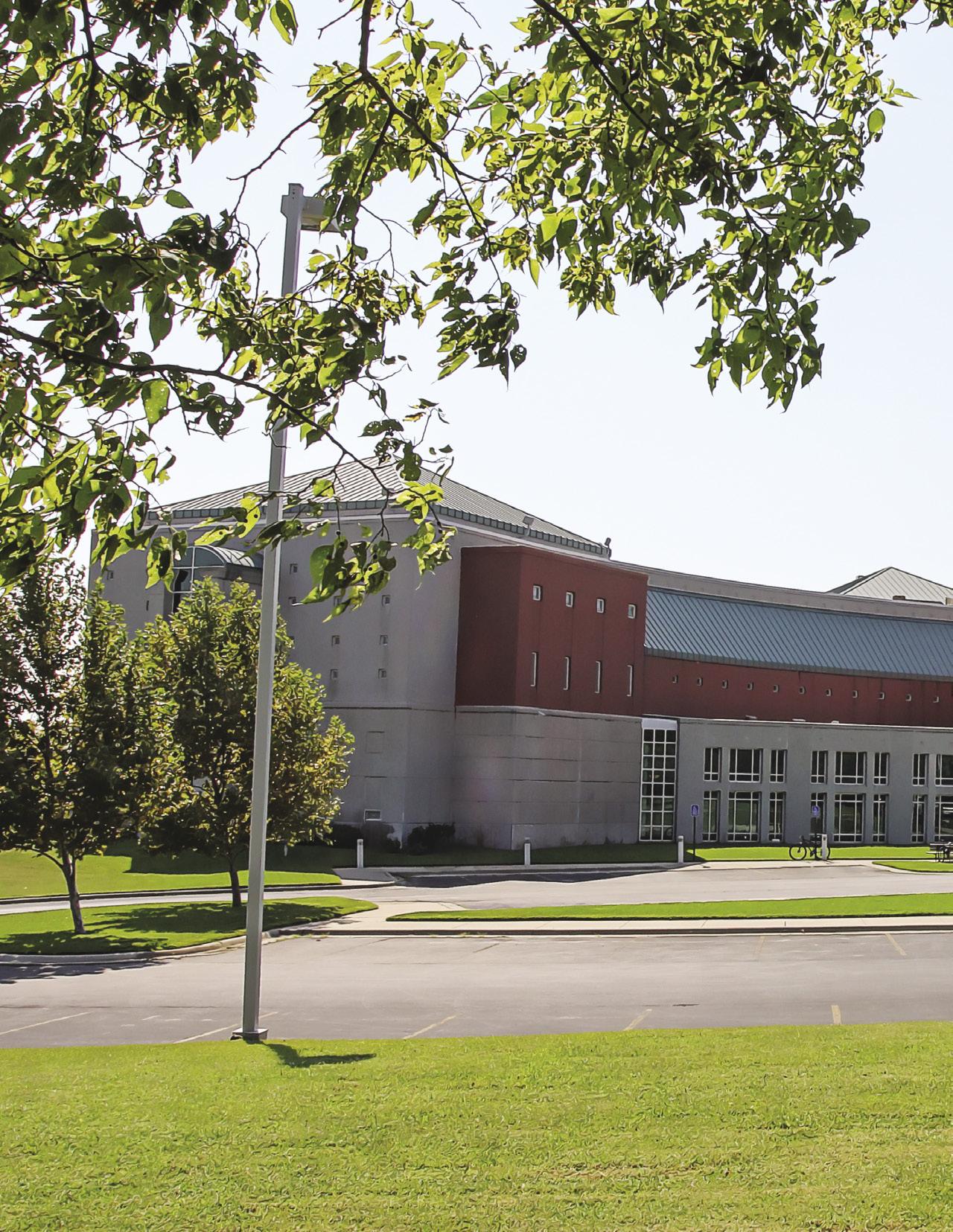
The last decade for the Douglas County Sheriff’s Office (DGSO) has seen both major change and the maintenance of the traditions of an office established in 1855. The main difference to the public is the person in office: That has switched from a Republican sheriff, Ken McGovern, to a Democrat sheriff, Jay Armbrister. But Armbrister says this change hasn’t been much of an issue for the community.
by Darin White, photos by Steven Hertzog
TO PROTECT & TO SERVE
The Douglas County Sheriff’s Office combines the new with the old to create an atmosphere that’s inclusive of all community members, including those who work within it and those who depend upon it.

“Sheriff McGovern did all the things that the community liked and did a great job building programs. The feather in his cap was our jail reentry program, which is the staff that helps people transition out of custody successfully back into the community,” the sheriff explains.
The DGSO Reentry Program staff helps get former inmates’ IDs and birth certificates, which helps them secure housing and stable employment. That process can be difficult, but imagine if you’ve been spun out for years not knowing if you even have the documents, Armbrister says. “They (the staff) have been lifesavers.”
The Douglas County Sheriff’s Office and DC County Jail

DGSO Staffing Challenges
The current Douglas County Jail opened on Sept. 11, 1999, with many new staff members hired to facilitate the needs and requirements of the larger space. One of these new hires was Armbrister. As many hires in that earlier group have retired or are near retirement, it has created staffing challenges for the Sheriff’s Office, compounded by the COVID-19 pandemic and surrounding communities bumping up pay in reaction to the labor shortage.
“With our recruiting, we could have overcome the pandemic, or we could have overcome the retirements, but we couldn’t overcome both of them,” Armbrister explains. “So the first two years we were short less than 10 people, and within four to five months, we were down over 30% in both corrections and operations.”
The Sheriff’s Office in 2023 did work with the Douglas County Commission, which supported a pay increase in late 2023.
“The last few months, we’ve seen a huge uptick in our recruiting, and so now it becomes a job (for) us to retain them, but it’s only been in the last few months we’ve actually felt like we are turning a corner,” he continues.
In addition to meeting staffing requirements, the department is also interested in the individuals they hire. “We want our agency to look like our community,” Armbrister adds.
Recruitment takes constant effort, and it’s been a mix of results. With retirements, the number of women officers dropped from close to 30% to around 20%, with the national average being around 12%. The agency in 2023 hired a transgender employee, and the team looks to expand the diversity through more resources in the community, including universities such as Haskell Indian Nations University. The department has seen a rise of staff from the Latinx community, as well, and it has provided a pay incentive for bilingual speakers.
Armbrister’s administration also created an LGBTQ+ liaison position and has sought to be more visible at Pride events in the region.
“Douglas County strives to be an open and accepting place for people of all backgrounds and orientations, and we want to do everything possible to keep it that way,” says Officer Kyle Appleby, the DGSO LGBTQ+ liaison.
58
Sheriff Jay Armbrister lecturing to the 2024 Leadership Lawrence Class






Social Justice, Law Enforcement and Corrections
As Armbrister campaigned for office in 2020, national events related to police brutality and rioting caused many conversations about law enforcement to commence.
“The deaths of Michael Brown and George Floyd, and others were tragic and should not have happened,” Armbrister explains. “These devastating situations did create space and demand from the community for us to have conversations and reevaluate systems that had been left dormant for so long. It was an opportunity for us to change our generation of law enforcement and corrections, and we were able to embrace this movement and come into office, and utilize those tools as opposed to operating with the status quo.”
He says a lot of what they were doing was good having inherited what he calls a “juggernaut of an agency.” It was an opportunity to discuss the good things law enforcement had done for so long as well as listen to and engage with the people who wanted to know more about what they do.
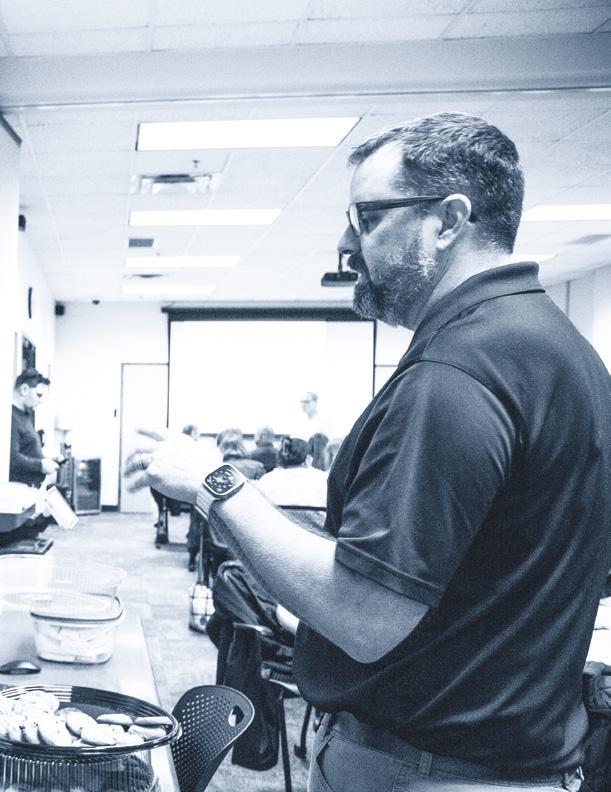
For one, Armbrister has worked to open up many things to the public and build on what the Sheriff’s Office had done in recent years.
“Education and transparency are the best tools law enforcement has,” he says. “When we see things the community could have a problem with, we try to be proactive and explain what they are and how we would use them.”
Creating Change
There are several different ways the Sheriff’s Office is looking to be more transparent and make positive changes.
The use of new technology can be a helpful tool if used properly. Before 2022, there were zero bodyworn cameras, and now all deputies and corrections officers wear them.
“They are helpful when people make complaints. We go back and look at the video, and can shed light on what happened. Usually it helps verify the deputy or corrections officer acted appropriately,” Armbrister explains. “There’s no two ways about it; they have

 Police Chief Rich Lockhart and Sheriff Jay Armbrister maintain a close relationship between their departments
Police Chief Rich Lockhart and Sheriff Jay Armbrister maintain a close relationship between their departments

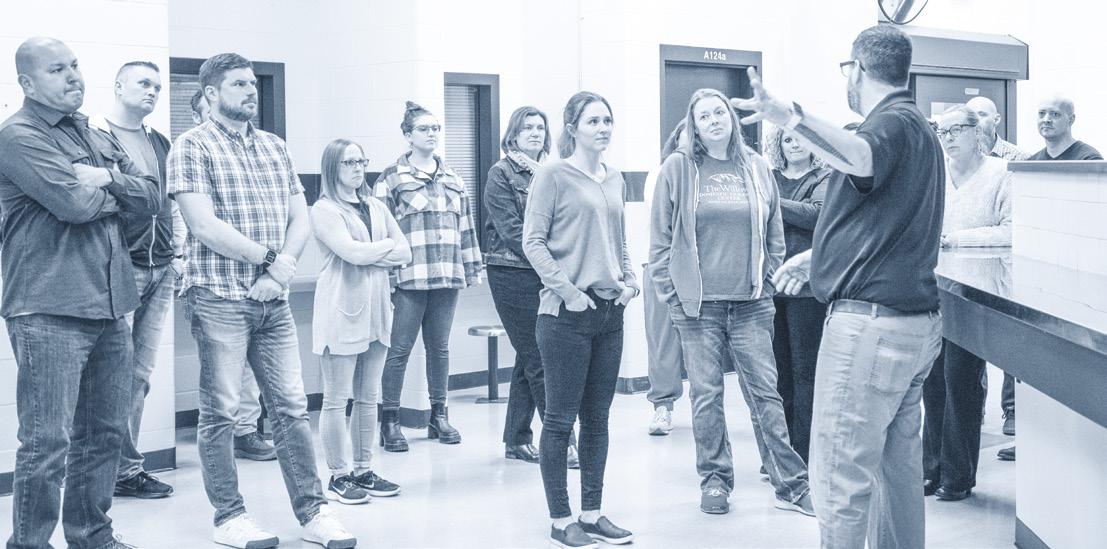

62
Sheriff Armbrister giving the Leadership Lawrence class a tour of the Douglas County Jail
made us better employees if you know that the witness that never blinks is watching. You do and say the right things, and so it makes our agency better.”
Other newer technologies being used are drones and license plate readers. The drones can be a huge help keeping officers safe in situations like investigating downed power lines or finding the source of a fire. While there have been concerns, Armbrister says the community has been receptive to the agency being up front and transparent about how it uses these tools.
“When people get upset about difficult things that happen nationally with law enforcement, I don’t blame anybody for that. But what I would ask is that people who do get upset (and) come to us and demand answers, that they also listen to us when we get them answers,” he adds.
Mental Health for First Responders
Since taking office, Armbrister and his leadership have made it a priority to make sure first responders receive the care they need, because they are more likely to face post-traumatic stress. “It’s specifically so we can make sure that people who are doing this dangerous and stressful job are the very best versions of themselves, because that is what the community demands.”
For example, if an officer gets a knee injury in a foot chase and needs to have surgery, the insurance pays for the surgery and rehabilitation, and the officer can retire early and take his or her full retirement. However, if in that same foot chase the officer ends up seriously hurting a person, and that takes a mental toll on the officer and prevents him or her from doing the job, he or she is not eligible for retirement.
The Sheriff has lobbied the Kansas Legislature to pass legislation allowing first responders to be eligible for workers compensation because of a PTSD (posttraumatic stress disorder) diagnosis, and his agency has paid for a psychologist to be available and on call, and work only with first responders.
“We don’t want someone that isn’t 100 percent out there. It’s OK to not be OK, but it’s not OK to stay that way,” he says. “It’s been wildly successful.”
Flora l Desig n Classes Bouquet of the Month



63

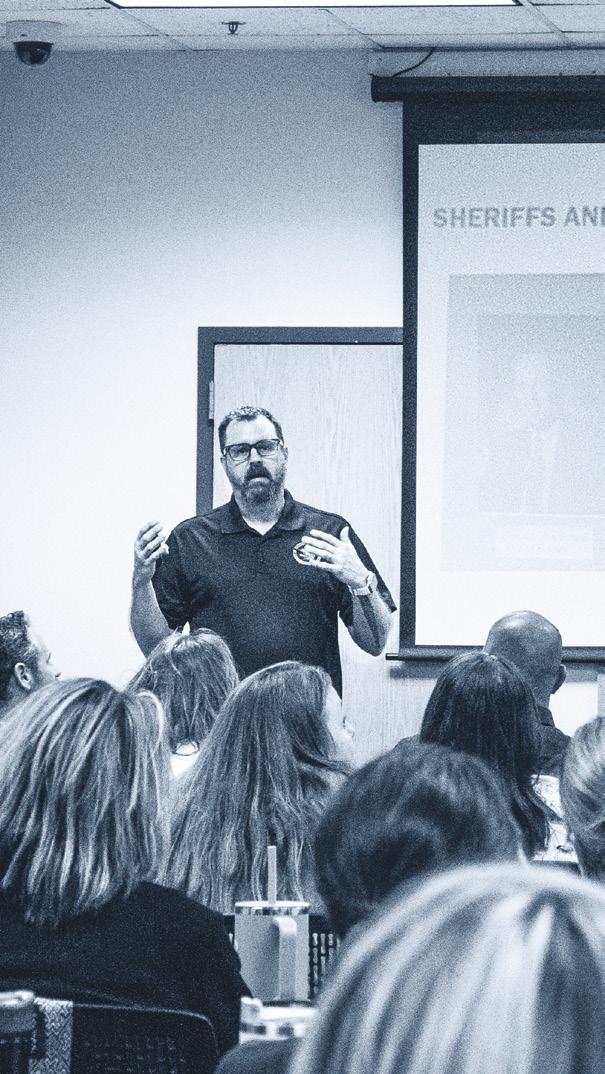
Looking Ahead
Sheriff Jay Armbrister lecturing to the 2024 Leadership Lawrence Class

Armbrister foresees a lot of conversations surrounding wind and solar in the community. While the Sheriff’s Office is not directly affected, the emotions that conversation has brought with the prospect of change in rural areas is “a hot-button issue,” he explains. Also, with more temporary workers, there is a tendency for this to bring a new dynamic to the area. No matter what happens in the community, the agency will continue to work to maintain its tradition of upholding public safety in all of Douglas County’s 475 square miles.
And this is the exact goal of the Douglas County Sheriff’s Office, to work for everyone. p


65

BALDWIN
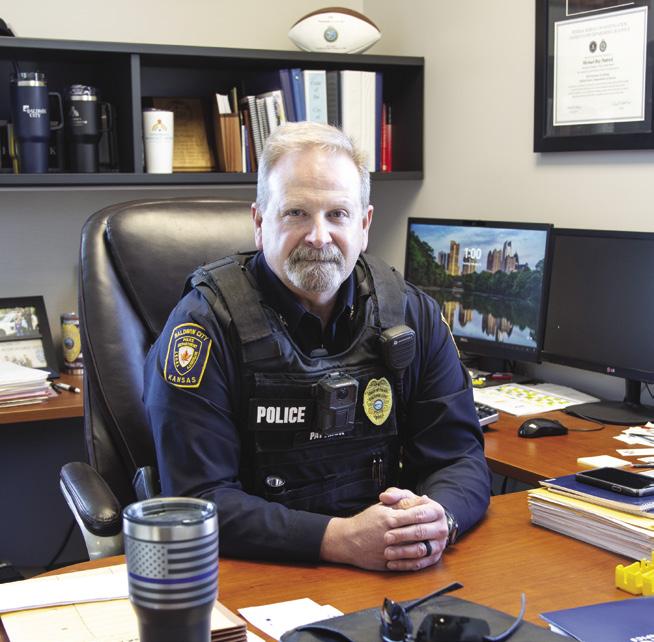
CONNECTING WITH
The slower pace of small-town life and familiarity of townspeople allows public safety officers to get to know the people who live there while also receiving fewer service calls.
by Bob Luder, photos by Steven Hertzog
There’s something special about small towns. The friendly relationships among neighbors and slower pace make them unique compared to larger cities.
Somewhat naturally, these distinctive attributes bleed into the experiences of those working in public safety in rural communities. Police officers getting called to the scene of an incident are more than likely going to know those for whom they are responding. They very possibly could be closely related. Fire first responders racing to a structure blaze or a medical emergency have a decent chance of having an outside relationship with a respondent, be it friend or family.
Ask a police officer, firefighter or paramedic how maintaining close relationships with the city fits with their job descriptions, and they’ll tell you it’s paramount to effectively keeping their communities safe and something they strive to improve upon every day.
“I love the size of this community,” says Eudora Chief of Police Wes Lovett, who came to Eudora, a small burg of about 6,500 a few miles east of Lawrence, seven years ago after 24 years working for the police department in Prairie Village, Kansas. “I love the pace. It’s different than what I’m used to in a bigger city.”
Mike Pattrick, chief of police in 4,700-population Baldwin City, says, “Everything we do is pretty much the same as in a big city, it’s just scaled down. We have fewer calls for service, but we have fewer people to respond.
“Baldwin City is a very nice community. We have very few calls where there’s violence involved. It’s a very supportive community,” Pattrick says. “To work in Baldwin City is a very nice thing.”
66


COMMUNITY EUDORA
Both Lovett and Pattrick stress that fostering small-town relationships is key to being effective public safety officers and first responders in their respective communities. Police officers are much more than ticket writers or keg party breakeruppers, just as much as fire department folks aren’t simply putting out fires or answering emergency medical calls. They’re friends and pillars of their towns and constantly engaging with the townspeople they serve.
For instance, the Eudora Police Department hosts events like “coffee with a cop,” “ice cream cones with a cop,” “pizza on patrol” and “lunch with law enforcement.”
“Sometimes, a grade-school kid might have a negative interaction with an officer,” Lovett says. “Sitting down and having lunch with that kid not only provides a positive interaction, but it only enhances our relationship with them.”
Working for Community’s Benefit
Nothing says caring for a community more than volunteering. And the Baldwin City Fire Department knows this all too well.
The department is made up of 12 firefighters—including two female members and one minority member—who all volunteer. They are only paid when they make calls and all hold down full-time jobs elsewhere. The department’s chief, Terry Baker, also runs a cattle operation near town and typically answers calls out of his farm truck 24 hours a day, seven days a week.
“If you think about the hours, it’s full time,” Baker says. “None of us are making a living doing this. But all of us who volunteer just want to give back to the community.
“We work really hard at being community-based,” he adds.
67
L-R: Baldwin Fire Chief Terry Baker Baldwin Police Chief Mike Pattrick Eudora Fire Department Volunteers Jacob Hankins, Chris Wolfe and Drake Patty-FF/EMT Eudora Police Chief Wes Lovett looking over daily plans with officers

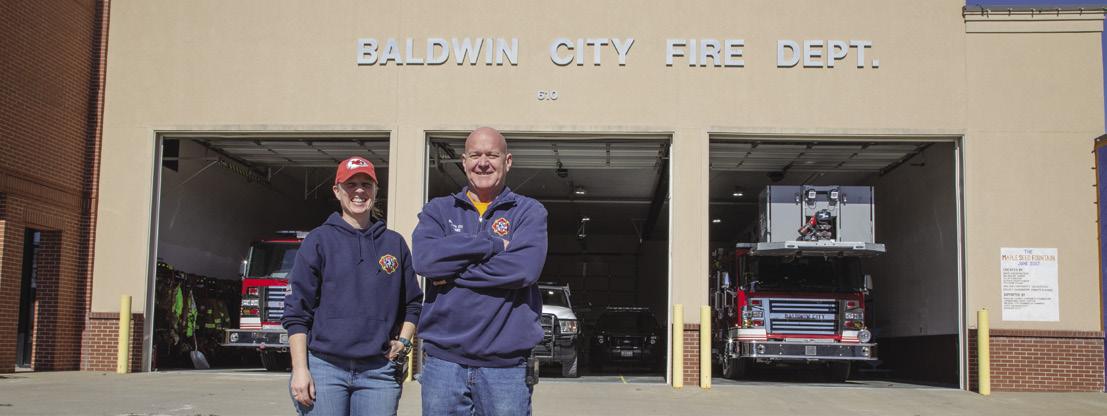
BALDWIN
 Baldwin Fire Dept Volunteer Becky Catron
Baldwin Fire Chief Terry Baker and Becky Catron pose in front of the Baldwin City Fire Station
Baldwin Police Chief Mike Pattrick and Baldwin Chamber of Commerce President Jenni Fish
Baldwin Fire Dept Volunteer Becky Catron
Baldwin Fire Chief Terry Baker and Becky Catron pose in front of the Baldwin City Fire Station
Baldwin Police Chief Mike Pattrick and Baldwin Chamber of Commerce President Jenni Fish
Baker says his department answers 3.7 calls per day on average and made more than 800 calls in 2023. It answers all medical calls in Palmyra District 2 but also works with the Lawrence Fire Department if it needs assistance or can be of assistance. It all adds up to a very busy schedule that also includes training, during which volunteers are not paid.
“It takes a special person to be a volunteer firefighter,” Baker says. “I’ve walked out of my house Christmas morning to take a call. People don’t understand what all we have to keep up on. My wife is starting to finally understand it after 15 years.”
Firefighting has gone through a lot of changes over the years because of technological advancements that have made “everything lighter weight and better,” Baker explains. Thermal-imaging cameras have improved, personal gear is lighter and more mobile, fire trucks are safer … . There’s even an app on firefighters’ smartphones that gives details on the jobs to which they’re called. The biggest challenge he says he’s faced is recruitment of new volunteer firefighters.
“It’s the toughest thing you can imagine,” Baker continues. “No one wants to give up their free time anymore. You have to be willing to give up the time, and that’s the problem.
“But the guys I work with now, I trust with my life,” he says. Baker sees the recruiting challenges easing in the coming years, however. Another technological advancement involves the rise of social media, and he says he’s using it extensively in recruiting new volunteers. Also, he’s hoping within the next five years or so he and his firefighters won’t have to be volunteers.
“What’s important to me over the next five years is getting the money to hire full-time firefighters,” Baker adds.
A Whole Different World
Eudora has what’s called a combination fire department. It has three paid employees: Chief Mindy Andrasevits, Assistant Chief Chris Hull and a part-time firefighter position that is filled 7 a.m. to 7 p.m. every day by different firefighters. All others are volunteers and paid per call. The de-

69

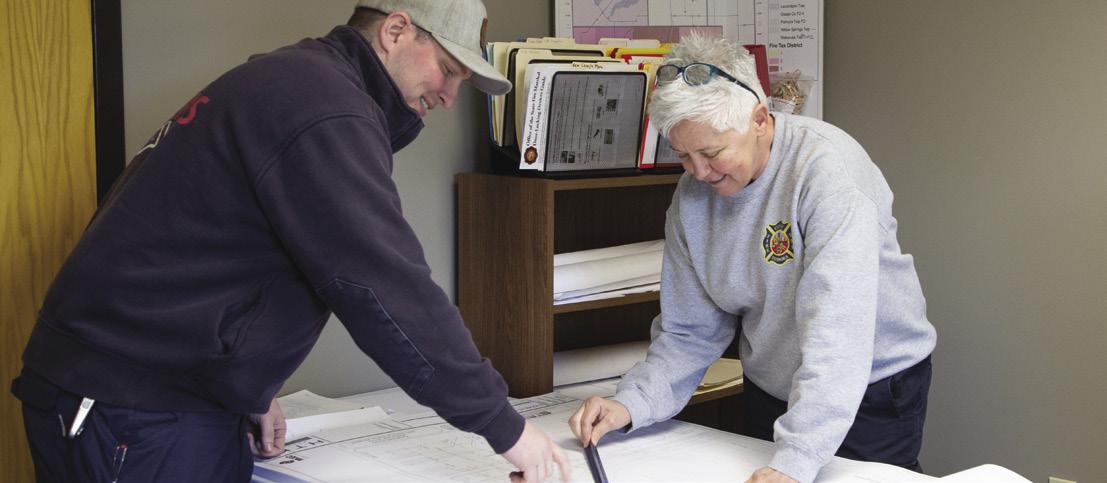
EUDORA
 Eudora Police Chief Wes Lovett visiting business owner Kathy Weld of Zeb’s Coffeehouse Eudora Fire Chief Mindy Andrasevits and assistant Chief Chris Hull Eudora Fire Dept volunteers prepare their fire truck
Eudora Police Chief Wes Lovett visiting business owner Kathy Weld of Zeb’s Coffeehouse Eudora Fire Chief Mindy Andrasevits and assistant Chief Chris Hull Eudora Fire Dept volunteers prepare their fire truck
partment tries to maintain a volunteer roster of about 40 firefighters, but that can fluctuate. Volunteers are required to be on the job 108 hours per quarter.
Andrasevits arrived in Eudora two years ago from St. Joseph, Missouri, where she worked with a full-time paid department.
“It’s similar but different,” she says. “We’re not any less busy here. A regular day doesn’t change.”
Andrasevits says surprisingly, calls were down six percent in 2023, 774 compared to 825 the year before. She anticipates that number growing to more than 1,000 in coming years as Eudora’s population grows.
Also somewhat surprising, she says she hasn’t shared the same challenges as Eudora’s neighbors to the south in Baldwin City. Many of her volunteers work full time as firefighters for neighboring districts.
“During my time here, I’ve been most amazed at recruitment,” Andrasevits explains. “The Eudora department has a long-standing reputation for being professional, having good training, proximity to larger departments.
“When we recruit, we’re often turning people away,” she adds.
While Andrasevits says her department “is not in a position right now to recruit specifically for diversity,” she currently has four female firefighters, one of whom is a lieutenant and two of whom are paramedics.
“In our department, word of mouth is so important for recruiting,” she says.
Like Chief Lovett in the Eudora Police Department, Andrasevits says she’s constantly working hard to see to it her volunteers are out in the community making connections and forging working relationships.
“A huge part of what we do is community outreach,” she says. “We have programs with the schools. We like to be seen and heard, and be part of as many things as we can.
“Eudora is going to change dramatically in the next few years, and the fire department is going to have to, as well,” she continues. “We’re proud that we’re a part of a community that’s growing and making sure public safety is part of that.”
The Changing Nature of Policing
The Eudora Police Department has 15 sworn officers (including a female school resource officer and two Hispanic sergeants), one part-time administrative assistant and a full-time court clerk, as well as 10 official police vehicles. Lovett says technology has completely altered the nature of those vehicles.
“Today, we have in-car (cameras), body cams,” he says. “Every car has a mobile data terminal in the car. You can basically do everything you need to in police work and never leave the car. It’s come a long way.”
That, of course, works counter to what Lovett wants from his patrol officers. Just like Andrasevits with the fire department or Pattrick and Baker in Baldwin City, Lovett wants his officers out of their cars and interacting with the community.
“We always have a presence at the (Chamber of Commerce’s) First Thursdays,” he says. “We usually have four patrol officers at every Friday-night football game.”
His department also sponsors at least five families at Christmastime, bringing gifts to homes and helping decorate trees. One of Lovett’s sergeants work with an organization called Hands to Heart to hand out toys to about 200 kids.
“They’re all ways to connect with citizens,” he explains. “We’re very fortunate to have the relationship we have with the community.”
Though Lovett admits recruiting new officers can be challenging, he maintains he’s avoided much of that challenge because of the closeness between police and citizenry.
“We’re fortunate we’re fully staffed,” he says. “We’ve hired quite a few people that grew up here, people who are dedicated to keeping our community safe.”
The biggest challenge in the coming years, Lovett says, will be keeping up with the growth brought about by the new Panasonic facility being built a few miles east, in DeSoto. It’s anticipated the plant will hire at least 4,000 new employees, and it’s reasonable to expect many of those workers will move into Eudora.
“That growth will bring in a lot of businesses to the area,” he continues. “Our biggest challenge will be adding people.”
71



THE CHAMBER Legislative Priorities Breakfast


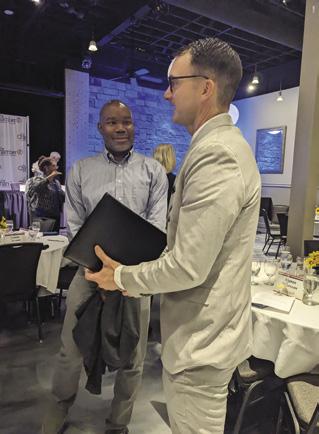



72
The Best They Can Be
Including Chief Pattrick, the Baldwin City Police Department has a force of 11 sworn officers, which includes two sergeants and eight officers. There also are two civilian staffers and three part-time positions that help out with special events. The department not only services the city limits, including Spring Lake, but also is law enforcement for Baker University. It has eight patrol vehicles.
The quiet, small-town nature of Baldwin City allows its police ample opportunity to get more involved in the community on a more personal level.
“Since our call volume is not as heavy, we have more opportunity to interact with the community on noncall situations,” Pattrick says. “Visibility is easier for us with the city not being as large.”
Still, he believes the public doesn’t always understand the amount of work police officers do behind the scenes to properly prepare for on-call matters and scenarios.
“They don’t understand the professionalism and time these officers put in to be the best,” Pattrick explains. “They all want to be the best police officers they can be.”
One challenge he sees is that improved technology has made everything instant. In the digital age, no longer is there lag time in communication. Being unreachable isn’t a thing anymore. People today are accustomed to quick turnarounds and responses at the drop of a second. Also, in the age of social media, privacy appears to be a thing of the past.
“It’s just a matter of getting to everyone and everything in as timely a manner as possible,” Pattrick says.
Like most other small-town forces, recruitment is a challenge in Baldwin City, he adds. What isn’t a challenge, however, is retention.
“Right now, it’s hard to retain young, enthusiastic people with the amount of pay we can offer,” Pattrick says. “There are so many agencies out there looking for good people.
“But, once we find the right people, they stay with it,” he says. p


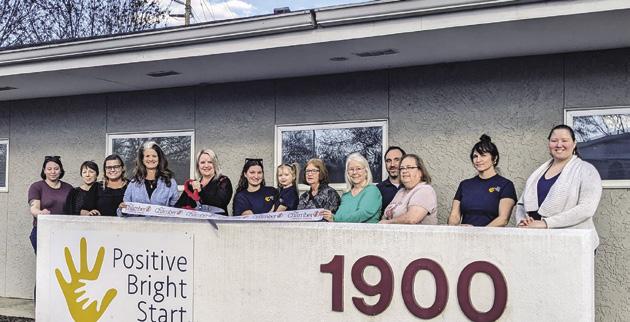




CHAMBER
Ribbon Cuttings • Events About Town
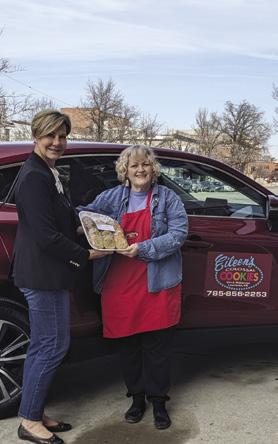
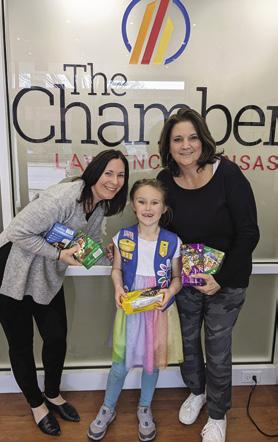
74






75








CHAMBER
ANNUAL MEETING
photos courtesy of The Chamber
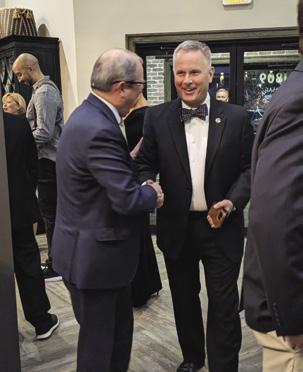

76











See all eventsupcoming online lied.ku.edu • 785-864-2787 Don’t miss out, buy your tickets and join NOW! with special guest Ally Venable Blues and guitar icon JUN 19 7:30 pm Dr. Jim & Vickie OT TEN Broadway’s Tony-winning master showman APR 1 7:30 pm 785-864-2788 • lied.ku.edu/donate Join Friends of the Lied 2024–25 season announcement in early May 2024 Friends of the Lied receive: • Discounts & advance ticket sales • Invitations to exclusive events • Recognition in the program • ...and more!






PINE LANDSCAPE EXPO



78




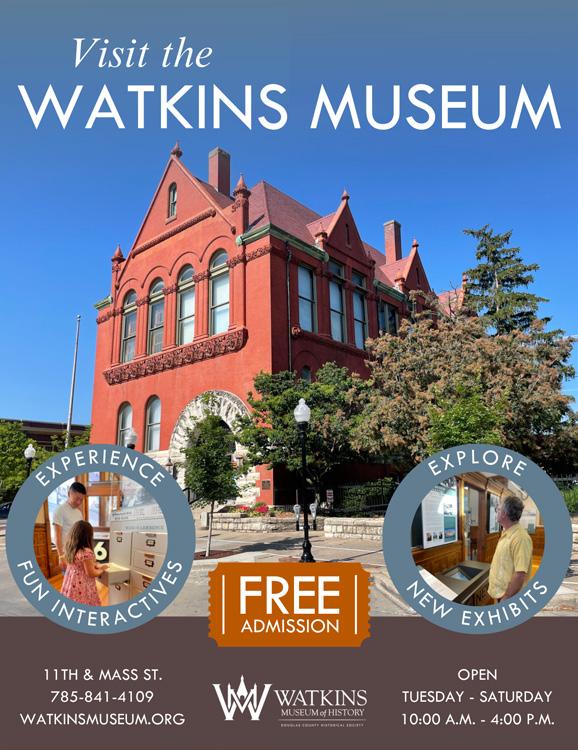


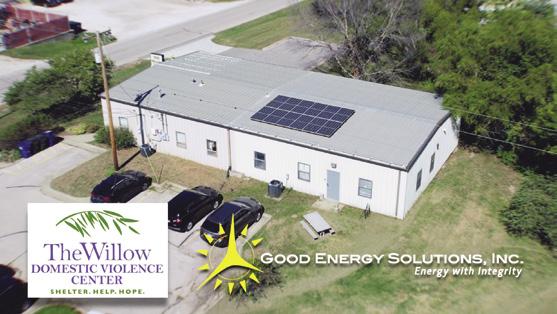
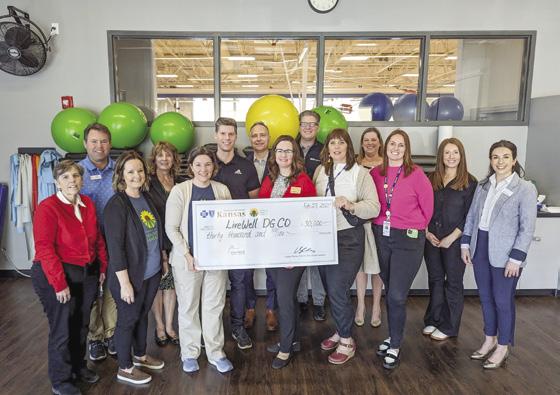
GOOD ENERGY SOLUTIONS
Solar Giveaway Program
- Willow Domestic Violence Center
Good Energy Solutions, one of the leading solar design and installation companies in Kansas and Missouri, cut the ribbon on the new solar panel installation for the office of The Willow Domestic Violence Center.
As part of Good Energy Solutions’ yearly giveaway project that donates solar panel systems to deserving Douglas County nonprofits, The Willow’s office, located at 1920 Moodie Rd, now has a fully operational solar array that helps to offset the cost of their monthly electricity bills.
“We’ve been giving solar systems away for many years, but this one is particularly special,” said Malcolm Proudfit, CEO of Good Energy Solutions. “This solar installation will help the Willow allocate more of their resources to accomplish their extremely important mission.”
The Willow builds safer communities through shelter, services, and support to survivors of domestic violence and human trafficking.
BLUE CROSS AND BLUE SHIELD OF KANSAS
Presents check to LiveWell Douglas County
Pathways to a Healthy Kansas, an initiative of Blue Cross and Blue Shield of Kansas (BCBSKS), presented a check to LiveWell Douglas County to implement Move More Douglas County, a physical activity prescription program, for local residents.
This new program aims to increase access to physical activity opportunities for patients by providing financial reimbursement for those activities. Health care providers at LMH Health and Heartland Community Health Center will provide the physical activity prescriptions to patients who are newly diagnosed with diabetes or prediabetes. Patients can then redeem their prescription at the Lawrence Parks and Recreation Department to use on a variety of aquatics and fitness classes.
“Being active has so many great health benefits, everything from sleeping better and feeling happier to managing blood sugar and blood pressure,” said Allison Koonce, LMH Health Community Outreach and Engagement Supervisor. “The Move More Douglas County program will help support the integration of physical activity into patient care plans.”
ANNUAL BUSKER FESTIVAL - RETURNING May 24 to May 26, 2024
Lawrence, Kansas, is gearing up for the 16th Annual Lawrence Busker Festival presented by Free State Beer, scheduled to take place from May 24 to May 26, 2024. This extraordinary event promises a weekend filled with oddities, wonders, and the finest street performances that will leave you marveling at the talent on display.
Circus on the Streets: Where Quirky Meets Magic
Prepare to be enchanted and amazed as Downtown Lawrence transforms into a playground for the peculiar during the Lawrence Busker Festival. Aptly themed "Circus on the Streets," this year's festival promises an unforgettable experience featuring a stellar lineup of world-class performers who will dazzle and delight audiences of all ages.
81 & PEOPLE ON THE MOVE NEWS [ ] MAKERS




How well do you know Douglas Co? Where or What is this? Be the first to correctly guess what this local landmark/icon is and/or where it is located. Winner receives a $50 gift card to 23rd Street Brewery. facebook.com/lawrencebusinessmagazine



Make an Impact. Advertise in the Lawrence Business Magazine!






 Ann Frame Hertzog
Ann Frame Hertzog
 Editor-in-Chief/Publisher Chief Photographer/Publisher
Editor-in-Chief/Publisher Chief Photographer/Publisher



 by Pat Michaelis, Ph.D., Historical Research & Archival Consulting
by Pat Michaelis, Ph.D., Historical Research & Archival Consulting


 Taken about 10am before crest had arrived. Cohen’s on 9th St near Santa Fe switches showing water afternoon July 12 after flood had broken dykes that morning and water high had attained about 28.5 feet.
Taken about 10am before crest had arrived. Cohen’s on 9th St near Santa Fe switches showing water afternoon July 12 after flood had broken dykes that morning and water high had attained about 28.5 feet.




 Ryan Sztorch and Bri Harmon-Moore
Ryan Sztorch and Bri Harmon-Moore
 Members of the Bert Nash Center Mobile Response Team
Members of the Bert Nash Center Mobile Response Team








































 Live burn Training conducted by LFD and other training photos by Taylor Mah
Live burn Training conducted by LFD and other training photos by Taylor Mah



























 KU Police Chief Nelson Mosley and KUPD Deputy Chief James Druen
KU Police Chief Nelson Mosley and KUPD Deputy Chief James Druen













 Police Chief Rich Lockhart and Sheriff Jay Armbrister maintain a close relationship between their departments
Police Chief Rich Lockhart and Sheriff Jay Armbrister maintain a close relationship between their departments

















 Baldwin Fire Dept Volunteer Becky Catron
Baldwin Fire Chief Terry Baker and Becky Catron pose in front of the Baldwin City Fire Station
Baldwin Police Chief Mike Pattrick and Baldwin Chamber of Commerce President Jenni Fish
Baldwin Fire Dept Volunteer Becky Catron
Baldwin Fire Chief Terry Baker and Becky Catron pose in front of the Baldwin City Fire Station
Baldwin Police Chief Mike Pattrick and Baldwin Chamber of Commerce President Jenni Fish



 Eudora Police Chief Wes Lovett visiting business owner Kathy Weld of Zeb’s Coffeehouse Eudora Fire Chief Mindy Andrasevits and assistant Chief Chris Hull Eudora Fire Dept volunteers prepare their fire truck
Eudora Police Chief Wes Lovett visiting business owner Kathy Weld of Zeb’s Coffeehouse Eudora Fire Chief Mindy Andrasevits and assistant Chief Chris Hull Eudora Fire Dept volunteers prepare their fire truck


































































